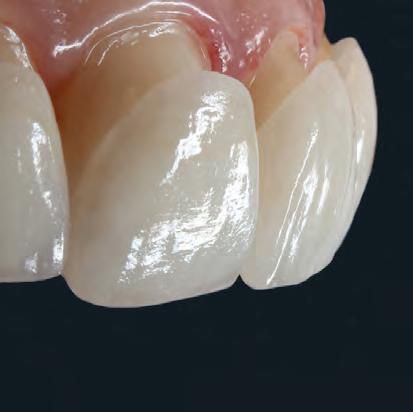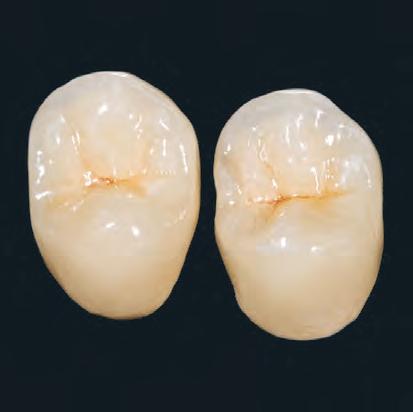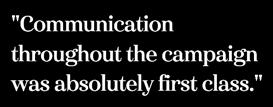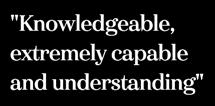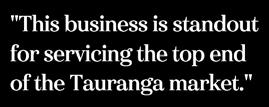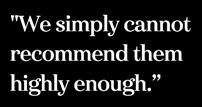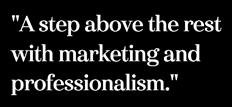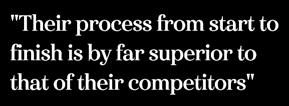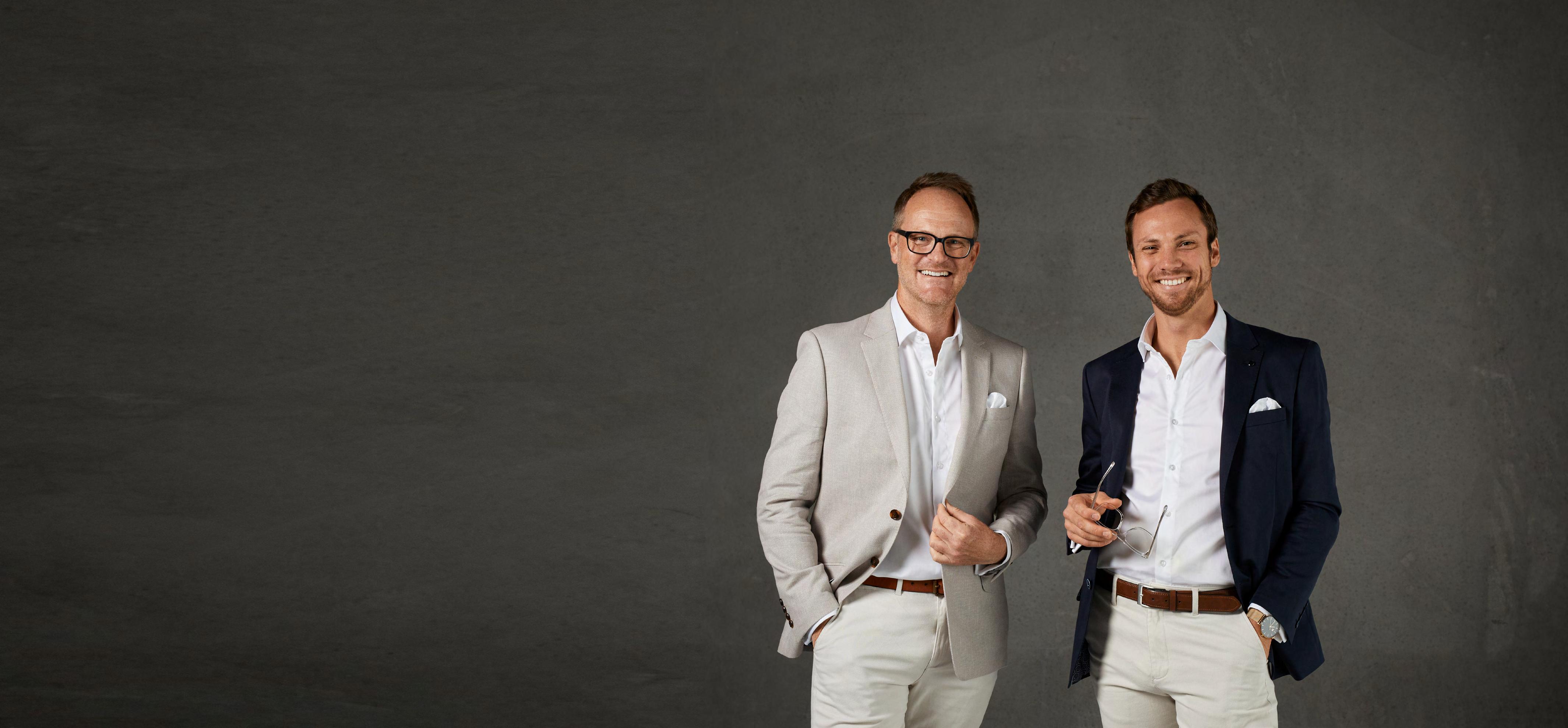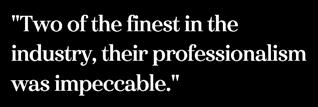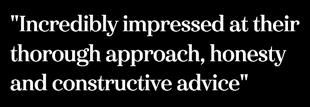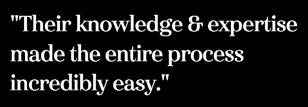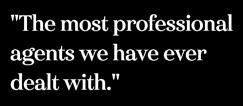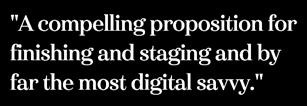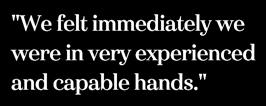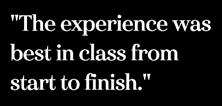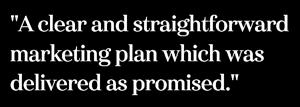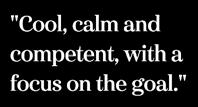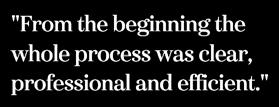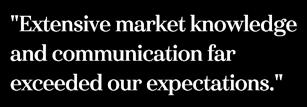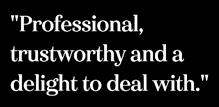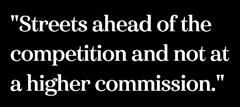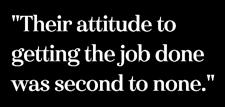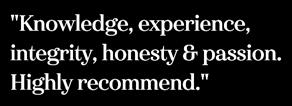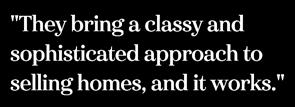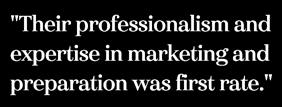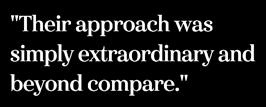
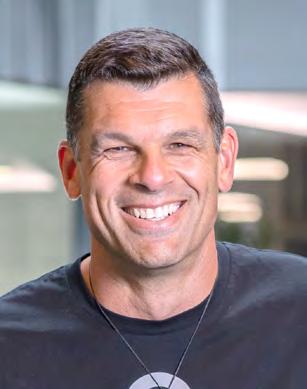

As
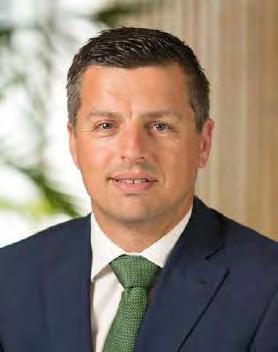
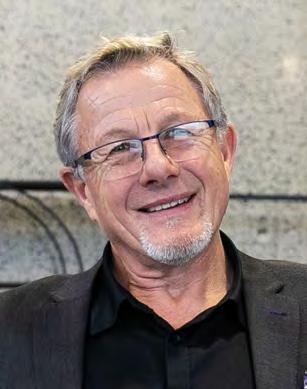
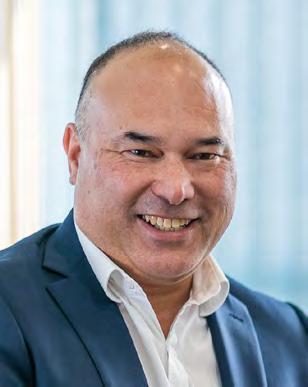
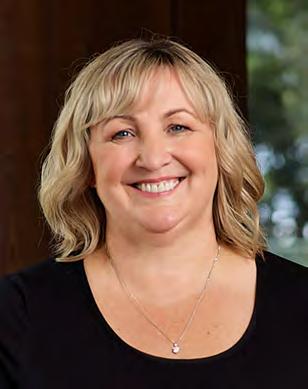
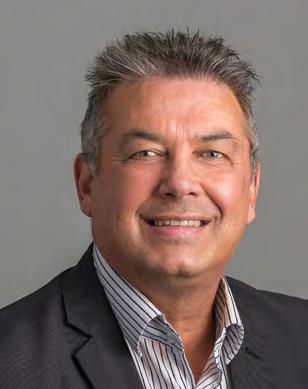
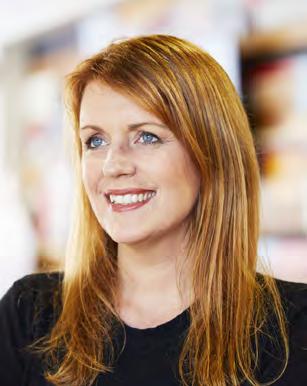
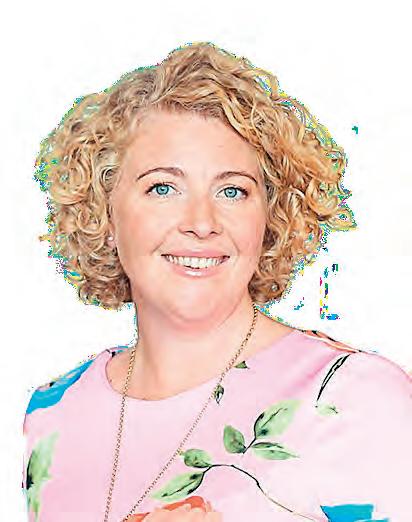

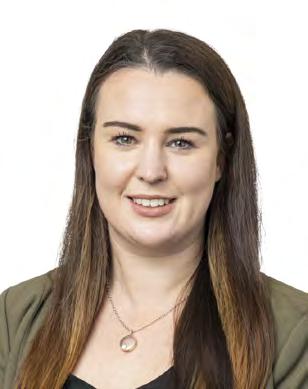
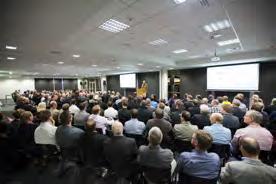

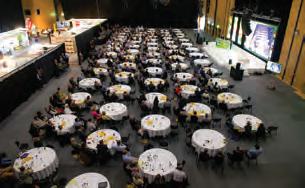














































































As






















































































New Zealand cybercrime continues to grow with the government cyber incident tracking agency, CERT, reporting a 14 percent increase in scams and fraud in the last quarter, says Digital Identity New Zealand (DINZ) executive director Colin Wallis.
By DAVD PORTER
DINZ is a not-for-profit mem-
ber association in the NZ Tech Alliance. Fraud awareness is now considered important for raising awareness of the potential risks New Zealanders are facing with increased online activity.
This just shows how critical digital identity trust is in a world that is rapidly becoming more digital, said Wallis.
Secure digital identities are an important foundation for the digital economy. And with so much business, communication and purchases happening online, it is more important than ever to be able to trust in people’s digital identity, he said.
Enabling the economy
“Having a secure, privacy-aware and trustworthy digital identity system will be important for enabling the economy. This is why DINZ members are collaborating to provide feedback via the submission process on the
government’s proposed digital identity framework.
“We are also hosting a large conference in May next year on digital trust, bringing together experts in digital identity, privacy and security, which are all needed to create trust.”
There is also a National Cyber Security Summit scheduled in Wellington early next year, which organ-
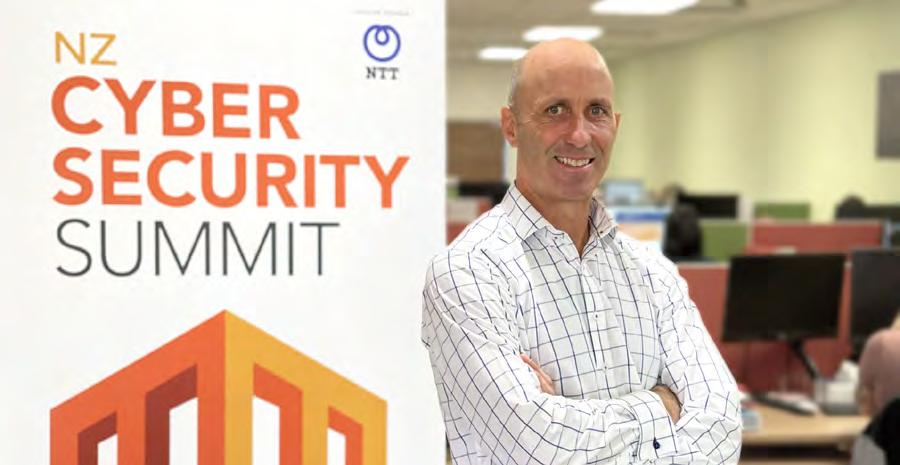
isers said was attracting huge interest. The cyber security summit next February is being staged by NZTech and Brightstar.
With the recent ransomware and trojan attacks both here in New Zealand and in Australia, cyber security has been catapulted to the top of every
Identity fraud has increased a staggering 86 percent in the last financial year, while investment fraud has risen by 37 percent over the same period.

business’s to-do list. Although there have been high-profile cases that have hit the news, CERT New Zealand has noted that cyber-attacks were up 65 percent in 2020.
Business critical activities have been disrupted, data has been compromised and the threat continues to evolve at a fast pace, said NZTech chief executive Graeme Muller.
“This year alone, many providers of essential services including energy, healthcare, food, and transportation have been hit by ransomware attacks which crippled their operations and had cascading effects on critical functions that we rely on,” he said.
Wallis said his organisation was working to create a country where people can express their identity using validated and trusted digital processes.
Identity fraud has increased a staggering 86 percent in the last financial year, while investment fraud has risen by 37 percent over the same period, according to the organisation’s fig-
ures. A total of 79 percent of New Zealanders are concerned about the protection of their identity and use of personal data by organisations, according to a survey commissioned by DINZ.
Wallis said there was public concern and some frustration about how their personal data is shared online.
A change in behaviour is occurring with 73 percent of Kiwis claiming to have made a change to their online behaviour because of privacy concerns.
DINZ found 85 percent of respondents said there was a lack of transparency, as well as expressing concern in having to share data with so many organisations. Additionally, only one in 20 New Zealanders have a fully satisfied experience with registering new accounts.
Perhaps unsurprisingly, nine out of 10 New Zealanders find the idea of being more in control of their digital identity appealing.
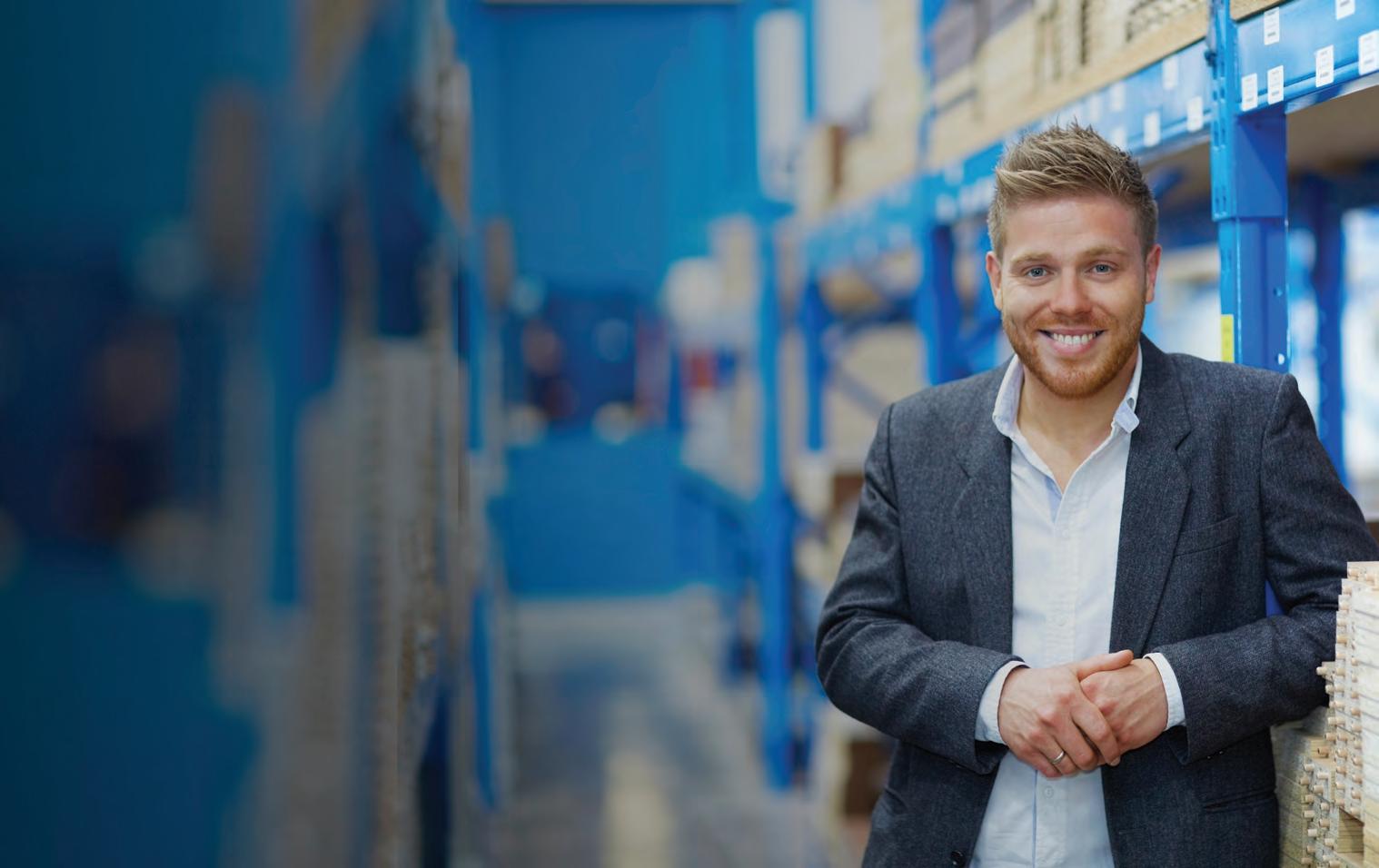
www.bopbusinessnews.co.nz
PUBLISHER
Alan Neben
Ph: 021 733 536
Email: alan@bopbusinessnews.co.nz
EDITOR
David Porter
Mob: 021 884 858
Email: david@bopbusinessnews.co.nz
PRODUCTION
Copy/Proofs/Graphic Design
Times Media – Clare McGillivray
Ph: (09) 271 8067
Email: clare@times.co.nz
ADVERTISING INQUIRIES
BUSINESS DIRECTOR
Pete Wales
Mob: 022 495 9248
Email: pete@bopbusinessnews.co.nz
EDITORIAL:
News releases/Photos/Letters: david@bopbusinessnews.co.nz
GENERAL INQUIRIES: info@bopbusinessnews.co.nz
Bay of Plenty Business News has a circulation of 8000, distributed throughout Bay of Plenty between Waihi and Opotiki including Rotorua and Taupo, and to a subscription base. www.bopbusinessnews.co.nz
Bay of Plenty Business Publications 309/424 Maunganui Road, Mount Maunganui, 3116
Bay of Plenty Business Publications specialises in business publishing, advertising, design and print media services.
It is with considerable pride that Bay of Plenty Business News brings you our Christmas edition as we move toward six years of successful print and digital publishing.
Perhaps only those of us with long experience in the publications’ business can appreciate what a success this is for an independent newspaper. We owe a great vote of thanks to our dedicated readers and loyal advertisers.
This year, we decided to explore a slightly different format for our endof-year issue and are looking back on the past year to reflect on the remarkable diversity of stories that we have covered.
As publisher Alan Neben notes in our introduction to this month’s cover story, we constantly have an ear to the ground to discover what topics are trending at any point in the year.
As we all know, this year has been one of bewildering change for Bay businesses as they have fought to keep going. In 2021 the mood of business has continually evolved as they have struggled to find new ways to thrive in difficult circumstances.
This month’s cover story simply confirms how well they have done under difficult and ever-changing circumstances.
Politics as usual
While our primary focus is on business not politics, it is difficult to escape the fact that some of the bloom has gone off the Labour Government that

















was so triumphantly brought to power in the last election.
We all sympathise with other regions that have endured even more frustrating shutdowns than we have in the Bay.
But there is also considerable trepidation at what the potential downside may be if Aucklanders, in particular, decide that the Bay is the perfect location to explore their freedom – assuming it is granted – over Christmas.
It has become difficult to escape the feeling that, no matter how likeable the prime minister is, Labour’s star is waning and this has been reflected in recent opinion polls. Essentially a feeling is growing that the prime minister is likeable
to many but not especially effective.
Despite the enormous advantage of being able to spend millions of dollars on often patronising antiCovid advertising – basically free advertising for the government – gaps are emerging in the government’s credibility.
One of the more glaring examples is of course the promised government acquisition of majority ownership of Three Waters assets, long held by local councils. It is quickly dawning on the public that the proposed “consultations” on the subject are a mockery that have no real likelihood of being entertained by the government.
As noted by Tauranga Commission chair Anne Tolley in an October media release, one thing is crystal clear.
“What we’re hearing loud and clear from our communities is that they don’t understand the reforms and would like Tauranga City Council to reject them,” said Tolley.
Equally disappointing is the government’s often shambolic performance on the MIQ facilities, which have drawn widespread condemnation.
As National’s Chris Bishop noted in a recent announcement, the party’s survey on the subject has been one of its most popular ever, with more than 90,000 responses.
“Secure digital identities are an important foundation for the digital economy. And with so much business, communication and purchases happening online, it is more important than ever to be able to trust in people’s digital identity.” – Colin Wallis Digital security more critical since Covid-19 – p3
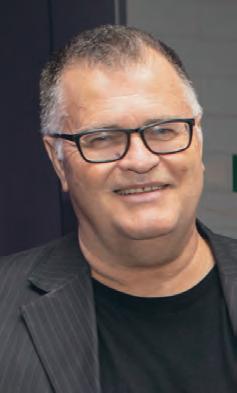
Says Bishop, MIQ made sense at the start of the pandemic. But now it’s just cruel and callous to stop fully vaccinated Kiwis coming home for Christmas when there are 5000 people alone in the North Island isolating with Covid (or close contacts) at home, he says.
‘It’s ludicrous that fully vaccinated travellers with no Covid go into MIQ, while people with Covid isolate at home in the community when they would be better off in quarantine.”
It is fair to say that this is politics as usual. And it must also be admitted that in opposition National has a long way to go as a viable alternative. Sadly, much of the blame for this lies with Judith Collins. Despite her undoubted talents, it is clear that she could not compete with Labour’s leader in the likeability stakes. As we went to print the party came to its senses and punished her ill-judged attempt to demote Simon Bridges by ousting her from the leadership. We shall see if a new leader makes a difference.
I wish all of our readers a merry Christmas on behalf of Bay of Plenty Business News.

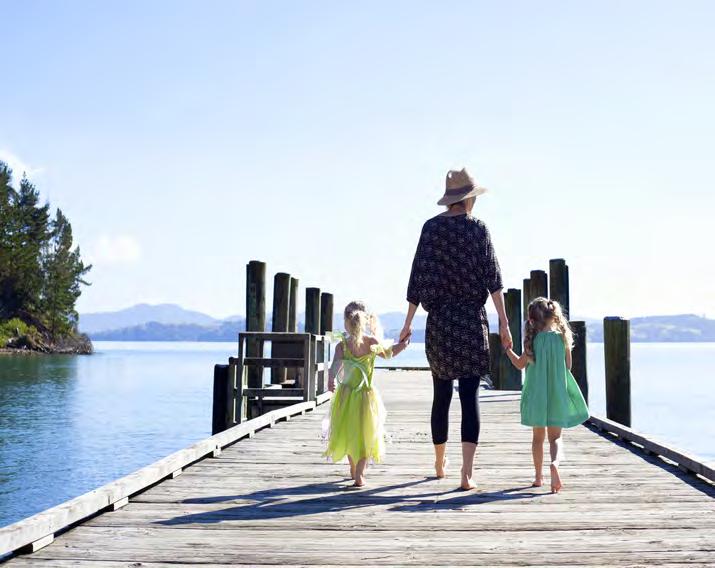
2021 may be drawing to a close, but business does not seem to be slowing down across the Bay. This month we welcome new business owners, new appointments and new divisions within existing companies. We look forward to the growth continuing in 2022.
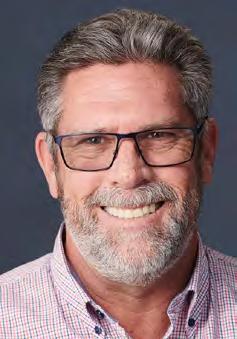
Oxygen8 Consulting Limited have appointed Chris Symes as Partner for the Bay of Plenty region.
Chris has a career spanning over 40 years specialising in roles ranging from technical, sales, marketing, strategy, management, business optimisation and advisory/consultancy services.
In Chris’s experience, the key to success of every business is the optimal performance, accuracy, efficiency, and overall job satisfaction of every staff member in the business. In doing so, he focuses on helping business owners build a solid foundation to maximise their business growth, profitability, and market value.
Oxygen8 Consulting is a New Zealand based company with a national network of Certified Consulting Partners.
Tauhara North Tourism Limited has confirmed Kiri Atkinson-Crean as Kaiārahi Tāpoi – Head of Tourism as the Trust begins its rebuild for the return of tourism.
Tauhara Head of Tourism, Kiri Atkinson-Crean comes to the role after 18 months with New Zealand Māori Tourism.

She was GM sales and marketing for Te Puia | NZMACI for eight years previous to that and has held other senior roles in tourism marketing, sales and operations.
Kiri says she feels especially privileged at her appointment and the opportunity to contribute to Tauhara’s tourism journey with operations including Tamaki Māori Village and Rapids Jet.

Creative communications agency, WAVE, has announced the expansion of its public relations and communications team in response to increased demand for PR support from its clients.
Based in Mount Maunganui, WAVE Creative Communications Agency looks after a range of reputable businesses nationwide from its sunny, beachside office.
Managing Director WAVE, Glenn Dougal said “We are so pleased to welcome two globally experienced PR professionals to our public relations and communications team, Anna Skerten and Ellen Hunt.
“WAVE is already managing brand strategy, marketing and digital for a growing client base, so it’s a logical step to round out our full-service offering.”
WAVE offers this service
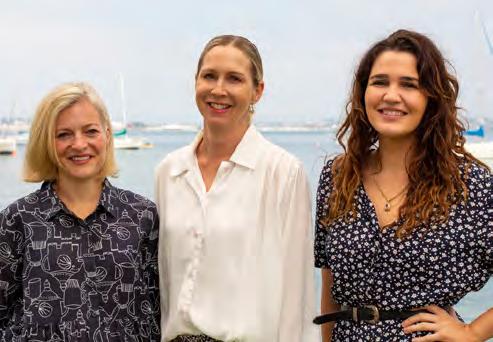
with an in-house team of three multi-disciplinary communications specialists, with Skerten and Hunt recently joining lead, Michelle Riley.
Skerten is a senior PR and communications expert with over 18 years’ experience working in-house and for PR agencies in Aotearoa and offshore including Ask Jeeves in the UK, and more recently, Spark and Chorus
and
She previously managed PR in Australia for technology start-up, Deliveroo and its operations in the UK & Ireland. Ellen got her start in broadcasting at Mediaworks NZ.
The Holland Beckett Rotorua team has the breadth and depth to cover all your legal needs, from property and commercial, to family law and civil litigation.
With a wide range of partners, lawyers, legal executives, and special counsel based in Rotorua, Holland Beckett has all the expertise you need, right here, when you need it.
Holland Beckett Rotorua is a one stop shop for all your legal needs. Contact our highly dedicated and experienced team today.
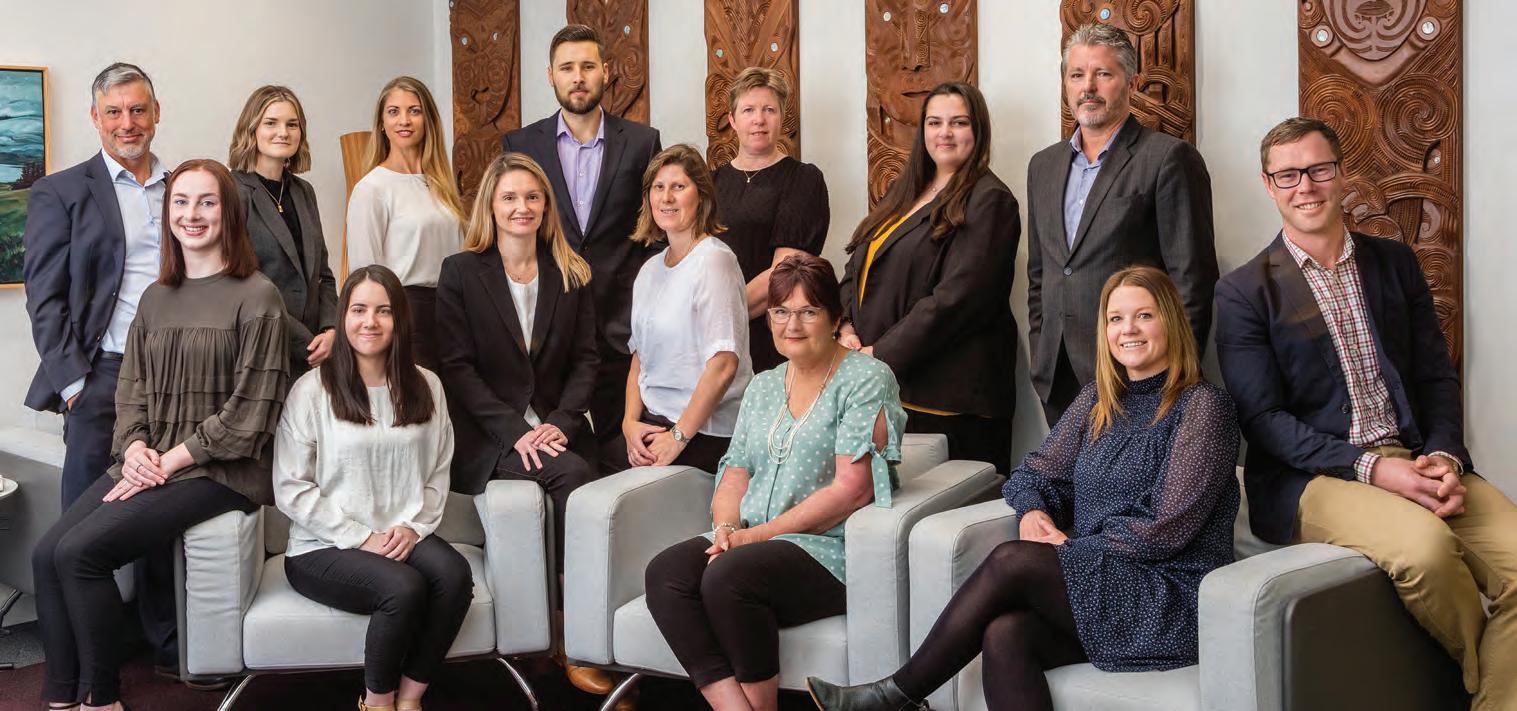
At Bay of Plenty Business News we constantly have an ear to the ground to discover what topics are trending at any point in the year. In 2021 the dial has continued to shift constantly – the mood of business has changed regularly since January as businesses have fought to find new ways to not only survive, but to thrive. In sitting down to review the year, I realised the easiest way to summarise the trends and chart the local business communities changing fortunes, was to look through each of our monthly editions one more time, rather than relying on memory. My verdict: “What a year it has been!”


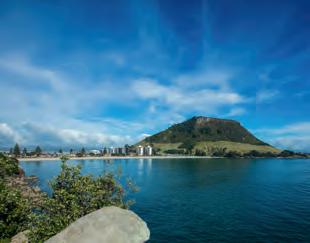








The somewhat prophetic cover headline of our January issue really said it all: ‘Recovery Stronger than expected – but uncertainties remain’ – and remain they have. Almost 12 months on and some questions still remain unanswerable: Can I buy a house? Will Covid chaos be gone soon? Can I go overseas? Although there were certainly positive signals in the January issue, like Carrus’ push into the Papamoa Junction development and stories on domestic tourism growth and positive small business employment signals.










One call that was a shot in the arm in terms of positive news in February was the announcement of the ground-breaking Luxridge luxury apartment complex in central Tauranga. When uncertainty seemed to be so pervasive throughout the community at the time, it was especially encouraging to hear Rob Gartshore of the Gartshore Group state “Luxridge has got it right”. We recently updated progress on the development in our November issue.

> BY ALAN NEBEN










One theme that has been a constant this year is building development. Our March issue epitomised this with a feature headline ‘Development Boom Hits Bay of Plenty’.
But it wasn’t all about development – we reported on improved Tauranga Port profits, Kiwifruit industry growth and Tauriko investment opportunities ‘going fast’ – and it seemed like a good time to launch our Luxury and Lifestyle column I thought!
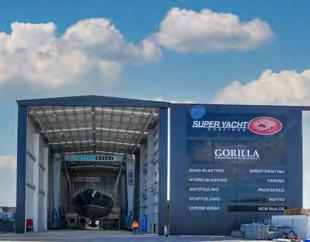








Tauranga’s Marine Precinct dominated our May issue as we looked at what our region offers in the way of superyacht facilities
It was also a growth time for BOP Business News as we saw the introduction of our monthly BOP Personality Profile (that month featuring BOP Regional Council’s Harbourmaster and Marine Manager Jon Jon Peters – a good yarn!). We also introduced NewsBriefs as a new design feature – one that has become a popular feature with readers.
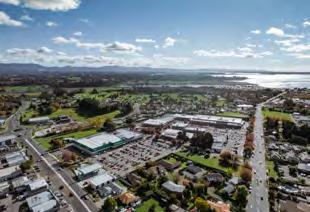








And more positive news as PMG announced its planned acquisition of the Bethlehem Town Centre – who says nothing much has been happening this year? Amongst other items of interest featuring in July, Brendon McCullum was introduced as guest speaker at the 2021 Tauranga gala dinner at Trustpower Arena, and we had a feature piece on Zespri’s record season - the news is not always bad!









While much of our editorial content has focused on Tauranga during 2021, it was wonderful to see Scion’s revolutionary Rotorua headquarters, Te Whare Nui O Tuteata, lead our coverage in the April issue. It was certainly a significant event that saw the PM and several MP’s join us at the opening that month
Tech in the Bay, our June liftout, broke new ground as we gave readers an in-depth look at the Bay’s vibrant tech-sector. Feedback indicated some of our readers were surprised by the extent of tech innovation in our region and appreciated the insights we dished up. Interestingly our feature writer Richard Rennie produced a pearler of


















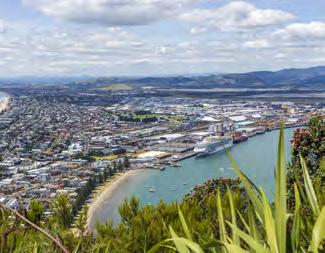








Warning: Urgent Action Required! The Bay Grapples With Urgent Housing Shortage. That’s how the front page headline read last month. Were we overstating it? I don’t believe so. As our editor David Porter put it in his editorial in that issue when referring to the regions’s housing crisis,”I had not realised to quite what extent the region has been victim of its own success.”
David spoke to economist Tony Alexander, Priority One’s Nigel Tutt, Rotorua Chamber of Commerce’s Bryce Heard and Carrus Corp’s Scott Adams, as well as Eastern Bay’s Karl Gradon to get comment and background for the lead article. It was not intended to sensationalise, but simply to give some opinion and background on the housing issues confronting our region – we trust you found it interesting.
Before we talk about the 12th and final issue for the year, I’d like to take this opportunity to thank our advertisers without whom we could not produce BOP Business News for the region’s business readers, and another huge thank you to our loyal readers.
The Leadership Issue. When the team suggested in July that we make the August issue the “Leadership Issue”, I was sceptical; “Everyone’s too busy and Covid has put a damper on that aspirational leadership pieces”, I thought.
I was wrong.
The invitation to prominent regional business leaders to share their thoughts on leadership was a real success and drew a lot of positive comment from our readers. To those leaders who participated and shared their experience, “thank you”.




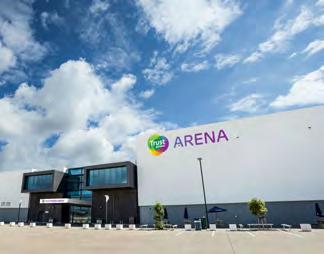







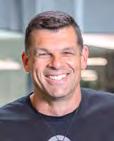









When the management team at Baypark Arena mentioned to me that it was the Arena’s 10th Anniversary my ears pricked up – I’d never thought about how long it had been there. To me Baypark was an institution that had been around forever, and the Arena seemed to cater to just about everyone in the Tauranga region. The editorial team thought it would be appropriate to cover the anniversary and it turned out to be a really interesting feature. Of note, “In late August 2011 the venue was opened, on time and within budget” – now how often do you hear those words in relation to big projects nowadays?













Not only did we produce the Post-Lockdown 2.0 Business Navigation Guide in our October issue, but we joined in celebrating their 30th Anniversary with Farmer Auto Village. No mean achievement for any business – congratulations again to the team at Farmer from the team at BOP Business News. Thanks also to the businesspeople who participated in the Post-Lockdown 2.0 feature, where we drew on the expertise of those professionals to tell us their stories.





The Thought Leaders issue. We’ve changed things up in this the December issue. We’ve said to our regular columnists, “take a break this month”, and we’ve focused the issue almost exclusively on what we’ve termed, thought leadership. As 2021 comes to a close we continue to be confronted with Covid problems, logistics and shipping issues and a housing crisis. Bay of Plenty Business News has focused on industry sector leaders and their thoughts on their own industries, their businesses and where the Bay of Plenty business community is headed in 2022 in addition to reflecting on the year that’s been 2021. I hope you find their comments useful.
(Don’t worry, our regular columnists will be back in January)
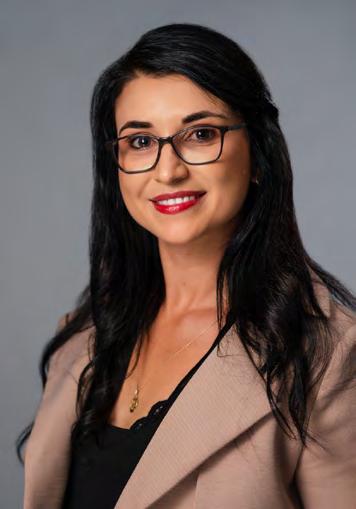

‘Uncertainty’ is perhaps the most appropriate way to describe the year 2021. Every company that has survived the last two years, including Stratus Blue, had to undergo a massive transformation — right from revamping business strategies to quickly adapting to the new norm.
The world of connected networks and information technology swiftly changed. Not only because of technological advancements but also due to remote working. You know well enough how the Covid-19 pandemic carved a complete social and professional change on numerous levels.
Of course, that translated to an intense impact on technology in the workplace and how businesses used it, but more pressing, the landscape of cybersecurity.
As a managed service provider (MSP), the last two years saw a sudden and dramatic increase in technical fire-fighting, setting up remote offices, troubleshooting security or operational issues, and connecting with the change in customer needs.
The past year has, as with many businesses in New Zealand brought about the challenges of unprecedented times as well as highlighted the fundamental part we play in business continuity, security, and proactive solutions, helping organisations to resume day-to-day business with little to no disruption and minimal risk to cyber threats regardless of the working environment.”
Forever adding to the building blocks for business success.
Stratus Blue has been operating as an MSP in the Bay of Plenty for five years, and we have viewed our role in our partnerships with our clients as an integral part of their business success by keeping their systems secure, and up to date while supporting them with technical requirements.
The past year however, has, as with many businesses in New Zealand brought about the challenges of unprecedented times as well as highlighted the fundamental part we play in business continuity, security, and proactive solutions, helping organisations to resume day-to-day business with little to no disruption and minimal risk to cyber threats regardless of the working environment.
The transition to a predominantly flexible and remote workforce shed light on the significance of a stable, reliable, and safe IT framework.
As Stratus Blue navigated the rapid demand for solutions that allowed businesses to be both agile and secure; we recognised that as an organisation we needed to become clear on our purpose, implement “the upskilling imperative”, and align ourselves with partners that are first in class solutions for our client needs. Our goal is to: “give businesses the freedom to be remarkable and leave their IT in our capable hands”.
Our purpose has driven us to launch an internal project with a focus on researching new software and technology advancements. Testing these platforms extensively has uncov-
ered how we can offer our clients the best possible protection; giving them confidence that they are operating in a reliable and secure digital environment.
To achieve this, we’ve gone through our own processes to ensure what we’re offering is the most appropriate service. We discovered that an Endpoint Detection and Response (EDR) solution was a vital part of our services that we needed to offer as a solution in the current cyber security threat landscape.
What is EDR and how does it work?
An Endpoint Detection and Response service aims to detect malicious activity and threats, and then applies appropriate action to prevent possible breaches.
EDR is a natural evolution of antivirus. It has artificial intelligence (AI) built-in, which analyses behaviour and looks for anomalies, patterns, or indications of a breach. The AI gets to understand normal working practices over time to offer further capability to help stop a breach.
EDR security solutions provide real-time visibility of network endpoints, as well as proactive capabilities for identifying and responding to endpoint threats.
EDR solutions enable continuous monitoring. You’ll gain the advantage of setting up automated processes that hunt down threats at the endpoint.
Threat detection capabilities vary from ven-
dor to vendor, but most scan for patterns and look for anomalies that represent malicious activity. Artificial Intelligence (AI) continue to study the network, users, and events, providing security teams with the most current information.
We’ve tested several options including CrowdStrike, Windows Defender and ESET EDR and our testing has led us to recommend SentinelOne. In the 2020 MITRE Ingenuity ATT&CK Evaluation – the most trusted 3rd party performance test in the industry – SentinelOne achieved record-breaking results, becoming the first EDR vendor to deliver 100% visibility of an attack with the most analytic detections 2 years running. The SentinelOne Singularity platform consolidated the 174-step campaign into just 7 console alerts out-of-the-box, automatically providing analysts with the context & correlation they need without extensive setup.
CrowdStrike’s performance missed the mark in speed and substance, only producing a third as many detections despite its 62 misses, delays, and configuration changes. It’s given us the confidence that we are partnering with the best supplier to provide the best possible solution.
This exercise taught us that in our industry it is essential for us to continue to stay on the edge of leading technology, to remain flexible, and continuously strive to position ourselves as the leaders in our field with a client and partner focus that sets us apart.
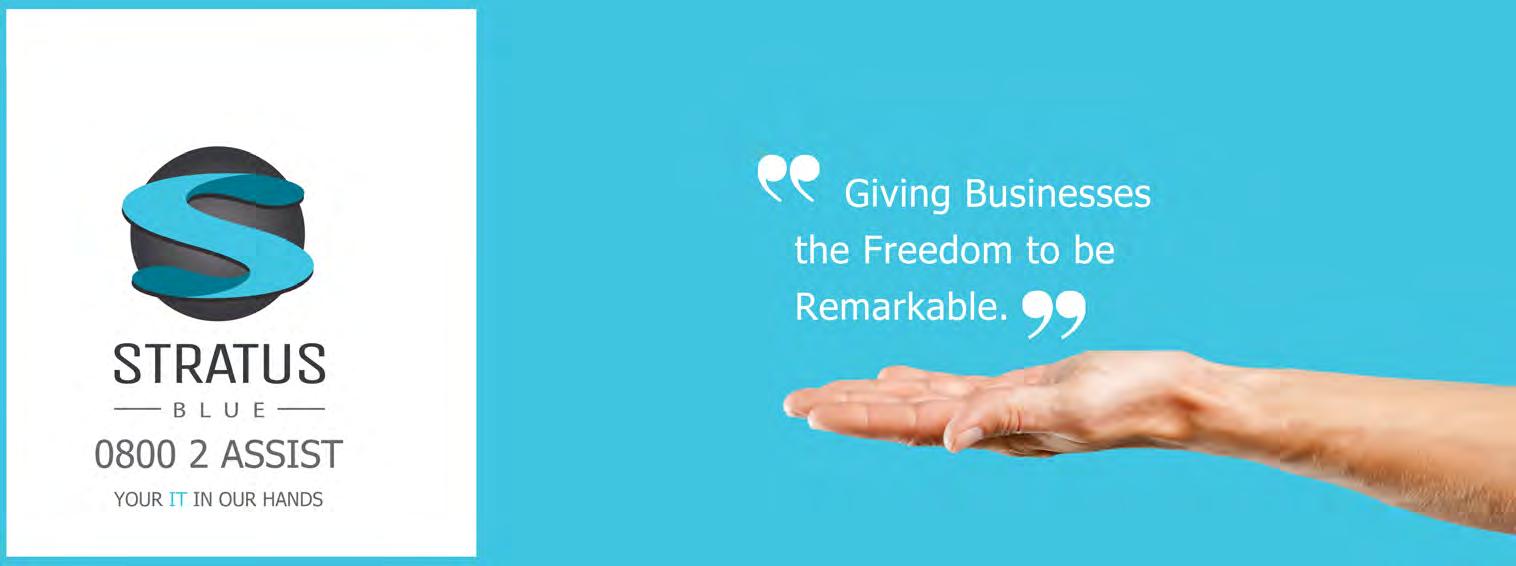
KATE ASHCROFT, Partner, Copeland Ashcroft
Kate acts for employers across a wide range of industries nationwide, giving advice and providing representation in disputes.
Many of us thought 2020 was the year of Covid, not realising just how much Delta would up the ante. The impact on workplaces has been huge, from closed borders compounding labour shortages, to vaccine mandates, and having to navigate untested waters under pressure, balancing legal considerations involving almost all workplace laws, from privacy and human rights to health and safety.
Statistics demonstrating the impact of Covid on everyone’s mental health are abundant, and many people have reconsidered their priorities and intent for the future. These factors are supporting New Zealand’s early experience of what has been termed “The Great Resignation”.
Closing out 2021: Where are we?
In summary, the takeaways for employers are: Clear communication with employees about your Covid workplace plan, from vaccination to protecting their safety, has never been more important – if you do not already have policies in place around this, you should.
Awareness of mental health impacts of work has increased and is a focus for WorkSafe. Your health and safety management plan needs to address this if it doesn’t already – training on psychosocial risks, and what this means in your workplace is a place to start.
Workplace culture to support retention and recruitment has also never been more important. Think about what makes you an employer of choice, and how you communicate this to the market.
• Employees are in demand, and they know it. They are looking for their best work life. Expect your team to be looking elsewhere if you haven’t taken steps to front foot that and secure their commitment to you. This
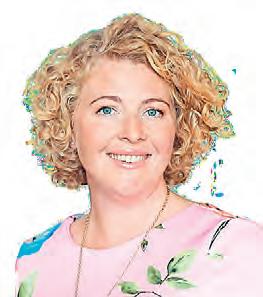
is almost always more effective (and often cheaper) than having to counter a potential new employer’s offer.
Check that your policies and documentation are fit for purpose. If the way you work has changed, do these reflect your “new normal”? For example, if you have employees regularly working from home now, have you done a health and safety risk assessment of their home workplace and covered expectations where they are working from home in a policy? Have you incorporated a requirement for vaccination to your recruitment documentation?
What’s on the horizon for 2022: prepare for change
• Covid management key in workplaces Covid will still be a “thing”, and as we settle into the new Covid Protection Framework, with businesses and borders opening up, responsibility for managing the risks relating to the spread of Covid will increasingly land with employers.
• Immigration changes
The Government has announced that all employers are required to be accredited with Immigration New Zealand and will come into effect in July 2022, with applications opening in May. If you employ migrant workers, being prepared early ensures the application process is as seamless as possible, given the high volume of applications expected.
• Holidays Act changes
In terms of new employment laws, the Government has indicated changes to the Holidays Act, adopting recent Working Group recommendations.
This will impact all employers and payroll providers and could see implementation of
Clear communication with employees about your Covid workplace plan, from vaccination to protecting their safety, has never been more important – if you do not already have policies in place around this, you should.”
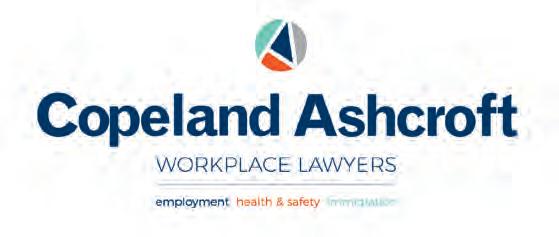
Copeland Ashcroft Workplace Lawyers provide specialist advice, representation and support across employment, immigration and health and safety law, to businesses throughout New Zealand.
Why us? Put simply, as specialists in employment, immigration and health and safety law, we know our stuff. That means we efficiently assist you with pragmatic and specific advice, to suit your needs. We know what works, and we partner with you to achieve the results you want so you can get on with business.

yet another “leave pay” calculation, as well as extended leave entitlements, and payslips to be required for all employees.
• Fair Pay Agreements
We anticipate the introduction of a new fair pay agreements framework, which aims to lift minimum industry standards.
Fair pay agreements will effectively operate as an “award” system similar to Australia and will set minimum terms and conditions for workers across an industry or occupation by a prescribed framework to bargain for these.
• Sexual harassment claim time extended
The Employment Relations (Extended Time for Personal Grievance for Sexual Harassment)
Amendment Bill has progressed through its first reading and proposes to extend the timeframe for raising a sexual harassment personal grievance claim from 90 days to 12 months.
The Bill was introduced on the basis that sexual harassment claims have special circumstances including in terms of the impact
for claimants, that potentially make the shorter timeframe unfair.
• Challenge to independent contractor arrangements
Scrutiny of independent contractor arrangements will continue, following several Employment Court decisions recently where contractors have successfully argued they are employees. This includes industries that have almost exclusively operated using contractors, like construction and couriers. Employers should look at their arrangements here to avoid potentially significant claims.
Preparation is key
After two years of necessary adjustment, astute employers will be well advised, and have forecasted for upcoming potential changes. Prepare early, as it’s even more important to get it right in today’s Labour market, to minimise the risk of potential expensive and time-consuming claims.

At the end of 2020, we felt somewhat confident in where the country was going. Covid cases were nil and Aotearoa was opening up again. It was exciting, especially after the ups and downs we’d experienced since April.
We saw small business owners all over the country adapt to a new Covid landscape, taking the steps necessary to remain operational and profitable should the country need to return to an Alert Level lockdown.
Kiwis became accustomed to scanning in at stores, restaurants and bars with the Covid tracer app, which became a part of our day-today routine.
We saw record high GDP growth in the September quarter, as the nation’s economy seemed to buck the doom and gloom trends of economists and media alike.
And then Delta hit.
Thankfully, the Bay of Plenty has managed to avoid the long tail of lockdown restrictions seen in other parts of the country.
But local businesses can still learn valuable lessons from how these regions have managed to pivot and remain relatively functional through digitalisation, which should be a key focus for small business owners in the coming months and years.
For example, where possible we saw small businesses pivot to e-commerce and online offerings, providing click and collect when and where it was an option - something that will
remain handy outside of lockdown.
Xero’s latest Small Business Index data shows a bounceback in sales in October 2021 after two months of declines during the Alert Level Four and Three lockdowns, with much of this owing to small businesses being able to remain operational.
As we pull the curtain on 2021 and prepare for the New Year and new traffic light system to manage Covid, now’s the time to look ahead and see what lies on the horizon for small business.
Digitising our small business community
Firstly, digitalisation is going to remain a crucial part of business development. For many, the Alert Level Four lockdown in April 2020 was a sharp awakening into the shortcomings of their operation.
Many had to react quickly to digitise in order to remain open. This change has continued well into 2021 with many small businesses changing the way they operate overall, embracing digital tools to improve their overall productivity and wellbeing. Of course, there’s still a way to go. We know businesses who digitalise their business are more profitable and productive than their counterparts.
Many small business owners think digital tools are for particular industries and mainly for office workers. But these days there are
specialist digital tools for every type of work.
It’s important you take the time to sign up to the Government’s free Digital Boost programme or check out our Why We’re In It guide to getting started with digital.
Preparing for new financial processes
Small businesses aren’t the only ones embracing digital processes to improve productivity.
E-invoicing is on the horizon for Kiwi businesses, aiming to simplify and automate the exchange and processing of invoices, all while removing human error. The main benefits include faster payment times and improved cashflow, along with reduced processing costs and more connectivity to other businesses.
Furthermore, while still in its infancy, open banking has the potential to revolutionise the way we do small business. In a nutshell, open banking refers to a framework where customer data is shared with trusted service providers.
This will enable these providers to offer a wide range of new financial services like account aggregation, instant credit risk assessments and subscription management.
Open banking is starting to gain traction globally and is something the Government is working to bring to our shores.
Reopening of the borders
As we move into the new traffic light frame-
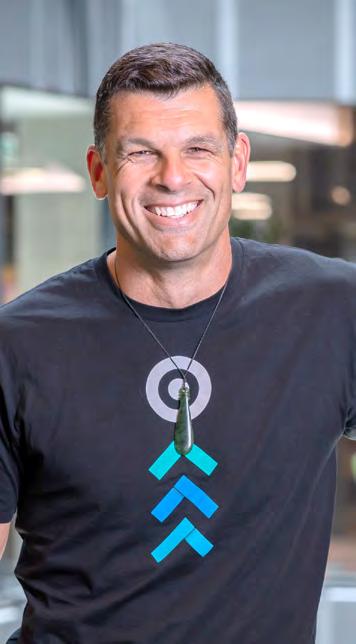
CRAIG HUDSON is Xero’s managing director for New Zealand and the Pacific Islands
work, there is likely to be increased pressure on the Government to reopen our international borders.
After all, the tourism industry has been severely impacted by the lack of international travel over the last 18 months.
When we open the gates there will be an influx of spending - as well as the potential for Covid outbreaks and potentially new strains.
No one knows the curve balls that will come in 2022, but I’ve seen the small business community adjust to everything that’s been thrown at them this year with determination and resilience.
I believe we’ll do well next year with our digitalised workforce, new technology coming through and international tourists on the way.
It’s what makes you turn up each day and keep pushing. It’s probably the same thing that made you start a business in the first place. But when the stresses of work get in the way, it’s time to take action and reconnect with your why.

Find ways to get back in touch with the reason you got into business, including making more use of digital tools and focusing on wellbeing in the workplace at xero.com/whywereinit.







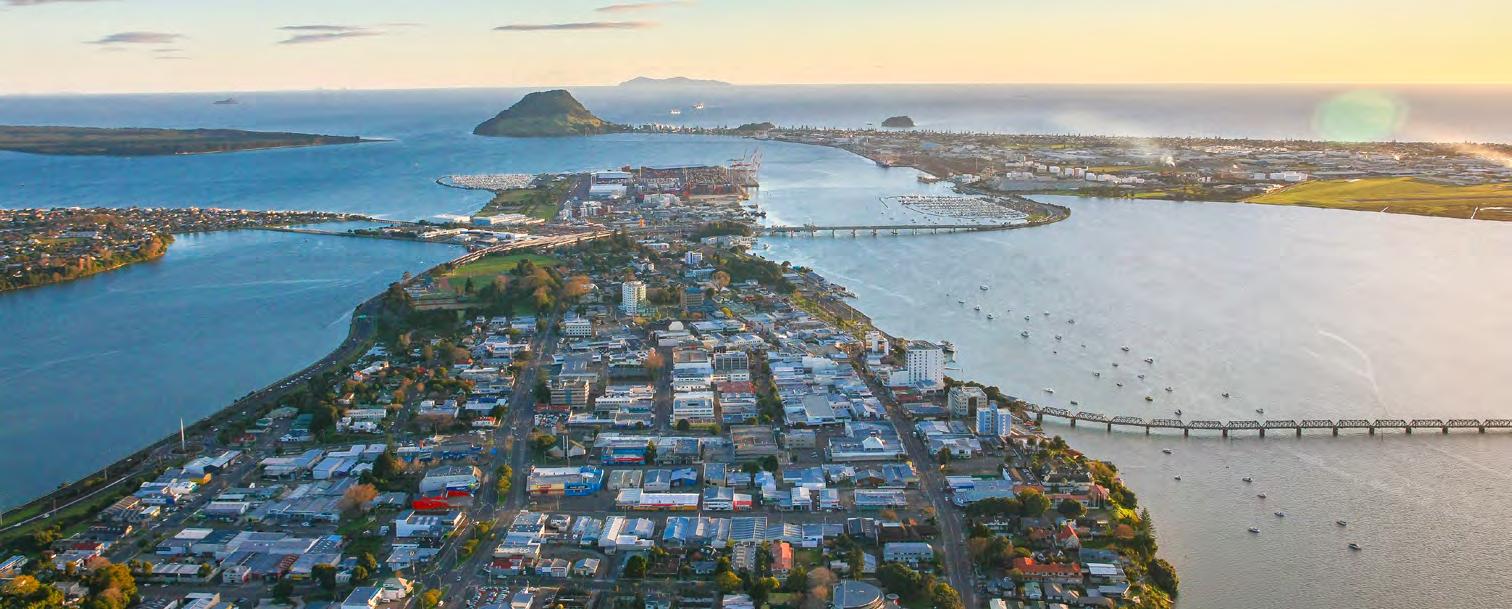
Clear, targeted and intergenerational investment asset management is the cornerstone of Quayside Holdings’ commercial returns. With a majority share of the Port of Tauranga and assets of $3.1b, Quayside uses an endowment fund approach towards our non-Port assets to ensure we remain commercially disciplined and community minded. What sets us apart? We know that investments are deeper than profits, providing a sustainable dividend back to the Bay of Plenty Regional Council (BOPRC) as our shareholder to support further regional development and services.
On 12 March 2020, sparked by fears over the coronavirus pandemic, the Dow Jones Industrial Average plunged 2,352 points (10%), the following day it was up over 1,985 (9.36%). Amongst the uncertainty of the fastest bear market in history, Quayside did nothing as the necessary steps had been taken well in advance.
“We had already planned for this event; having sold off a large number of the financial and consumer discretionary stocks from our portfolio in early February anticipating that these would be hit hard in the short-medium term. Later we used the crash as a buying opportunity, picking up some undervalued stocks which subsequently performed well,” said Brendon. “Investors who didn’t panic have been well rewarded”.
Fast forward to now and Quayside has posted yet another record year. In the year to 30 June 2021, Quayside’s profit was $154.1m. For the first time in its history, the profit from the non-port portfolio was greater than that derived from the Port of Tauranga, returning over 28% for the year.
Quayside has a wide investment mandate that allows it to consider a mix of assets and opportunities not available to most institutional investors.
From direct real estate assets to horticulture, international private equity to pre-revenue companies; these assets are all picked to perform differently under various economic conditions, allowing Quayside to weather the uncertainty prevalent in markets through uncorrelated returns. This approach to portfolio construction and asset management is based on higher investment allocations to the less-liquid sectors, which requires a real commitment to a longterm strategy.
While Quayside’s portfolio is still dominated by a 54.14% stake in the Port of Tauranga, in 1999 a strategic decision was made by the Quayside Board to start diversifying the investment portfolio. Today the non-port investment portfolio is valued at around $450m (around 15% of the total asset base) and this is forecast to grow rapidly in coming years.
“Ensuring the right blend of assets is a true balancing act at times; you always need to
BRENDON BARNES, Quayside Chief Investment Officer (CIO) since 2015, shares with us his thoughts on the key aspects of a considered, yet bold, asset management framework. With broad experience both nationally and internationally, including working for a sovereign wealth fund in Abu Dhabi, Brendon leads Quayside’s team of investment experts.
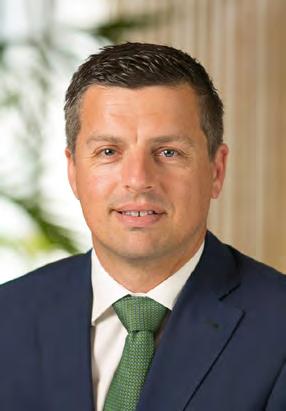
have one eye on the future. Conditions change, opportunities arise, things don’t go according to plan. We benefit greatly from an experienced and diligent team who are all focused on the strategy”.
The impact of the Quayside model is largely unseen, but everyone in the region benefits. This year’s dividend to the BOPRC has reduced the rates of every household in the Bay by $289 per property.
“In the past year we have engaged with others who want to learn more and replicate the Quayside model – we really don’t know how lucky we are here in the Bay. A healthy portion of growth assets are needed to sustain the dividend to Council and our community, rather than just focusing on investing for yield”.
The size of the Quayside balance sheet, in particular the non-port portfolio, allows Quayside to periodically execute transactions that bring substantial regional benefit, including issuing $200m Perpetual Preference Share on the NZDX in 2008; the proceeds of which were spent on regional infrastructure projects. This spring, earthworks commenced on the long-awaited Rangiuru Business Park which will bring significant returns to the wider community.
Brendon says that “You can consider us the Bay of Plenty’s sovereign wealth fund (NZ Super Fund equivalent); this responsibility is certainly not something we take lightly. We pride ourselves on delivering outcomes that positively impact the community we live in.”
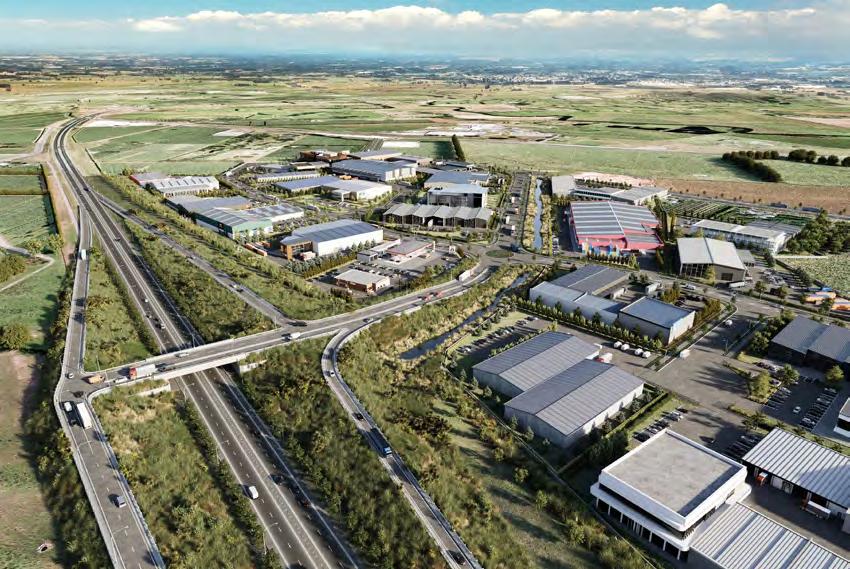
Port of Tauranga is embarking on its next stage of capacity growth to enhance New Zealand’s connectivity with the world. After a year and a half of pandemic-related disruption, the Port is planning ahead to preserve market access for importers and exporters based in the Bay of Plenty and beyond.
Port of Tauranga Chief Executive, Leonard Sampson, says three significant initiatives are helping the company prepare for the future.
The first to fruition will be the inland port under construction at the Ruakura Superhub logistics and industrial precinct near central Hamilton. The inland port is a 50/50 joint venture between Port of Tauranga and the Superhub’s owners and developers, Tainui Group Holdings.
The inland port will allow shippers to store and aggregate cargo for the “big ship” container services calling at Tauranga, while avoiding creating bottlenecks. The nine-hectare first stage is due to open in mid-2022 and future stages will see it grow to around 30 hectares. It will have two 800 metre rail sidings of the East Coast Main Trunk rail line.
Mr Sampson says Port of Tauranga is investing in the development for economic, social and environmental reasons.
“The Superhub and inland port will help us better service importers and exporters in the Auckland and Waikato regions utilising the existing rail network,” he says.
Port of Tauranga’s other two initiatives involve extending capacity at the Tauranga Container Terminal by extending the berth to the south of the existing wharves, and auto-
mating the adjacent container storage area with electric stacking cranes. The developments will allow the Port to increase capacity without expanding beyond its current footprint.
Port of Tauranga has applied for resource consent for the berth extension project. The $68.5 million first stage will create an estimated 368 jobs through the construction phase, and more than 81 permanent jobs after completion.
Mr Sampson says the project is of national significance. “It will bring urgently needed capacity and resilience to New Zealand’s supply chain,” he says. “We wish the process for gaining a consent didn’t take so long, but we are hopeful we can bring some much-needed capacity to the system before too long.”
In the meantime, the Port is doing what it can to relieve supply chain congestion.
The Covid-19 pandemic has caused widespread disruption to the international supply chain, through surging consumer demand and interrupted production cycles.
“We’ve worked really hard with our partners such as KiwiRail to increase the cargo volumes we can currently handle. In May, we were able to increase our train programme between Tauranga and Auckland from 72 trains to around 92 trains per week,” he says.
Mr Sampson says a pandemic-prompted
container vessel building boom is under way and is likely to accelerate the trend towards fewer but larger vessels calling in New Zealand.
Bigger ships have the advantage of being more fuel efficient and have a lower carbon footprint.
“By far the biggest proportion of carbon emissions in New Zealand’s container supply chain relates to the blue water of ocean-going component of the cargo journey,” says Mr Sampson.“Landside emissions from road or rail transport contribute only a small percentage of the total carbon emissions related to container imports and exports.
“Port of Tauranga is the only New Zealand port able to handle larger container vessels.”
Meanwhile, Port of Tauranga continues to build relationships with customers, business partners and the community to ensure its ongoing success.
“We are very proud of the wide-reaching benefits that the Port brings to the Bay of Plenty. As well as the jobs associated with the Port and other businesses, we have invested in community infrastructure,” says Mr Sampson.
More than half of Port of Tauranga’s shares are owned by local ratepayers. The company’s cornerstone shareholder is Quayside Holdings, the investment arm of the Bay of Plenty Regional Council.
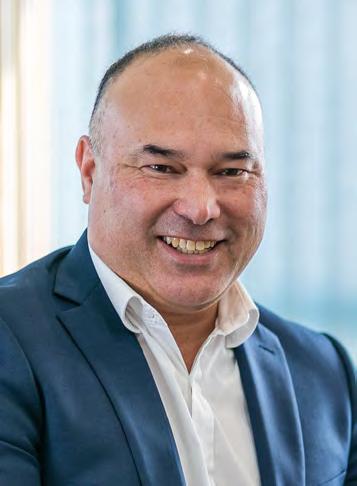
LEONARD SAMPSON, Chief Executive Officer, Port of Tauranga
Quayside has received dividends of more than $905 million in total since Port of Tauranga was listed on the stock exchange in 1992. Dividends paid by Quayside represent around 25% of the Council’s annual income.
Quayside has also used its shareholding to establish a $200 million infrastructure fund that has helped pay for regional assets.
Apart from the dividends, Port of Tauranga has invested directly in many community projects, including sponsoring the construction of the Pilot Bay boardwalk, upgrades to the walking tracks on Mauao and the installation of lights at the Bay Oval cricket ground.
Mr Sampson, who took over the role of Chief Executive in July 2021, says he is looking forward to growing the partnerships that contribute to community wellbeing, such as the Port’s new sponsorship of the 2022 National Jazz Festival in Tauranga.
“We’re very pleased to lend our support to ensure the festival continues to entertain and uplift thousands of locals and visitors while bringing economic benefit to our region.”
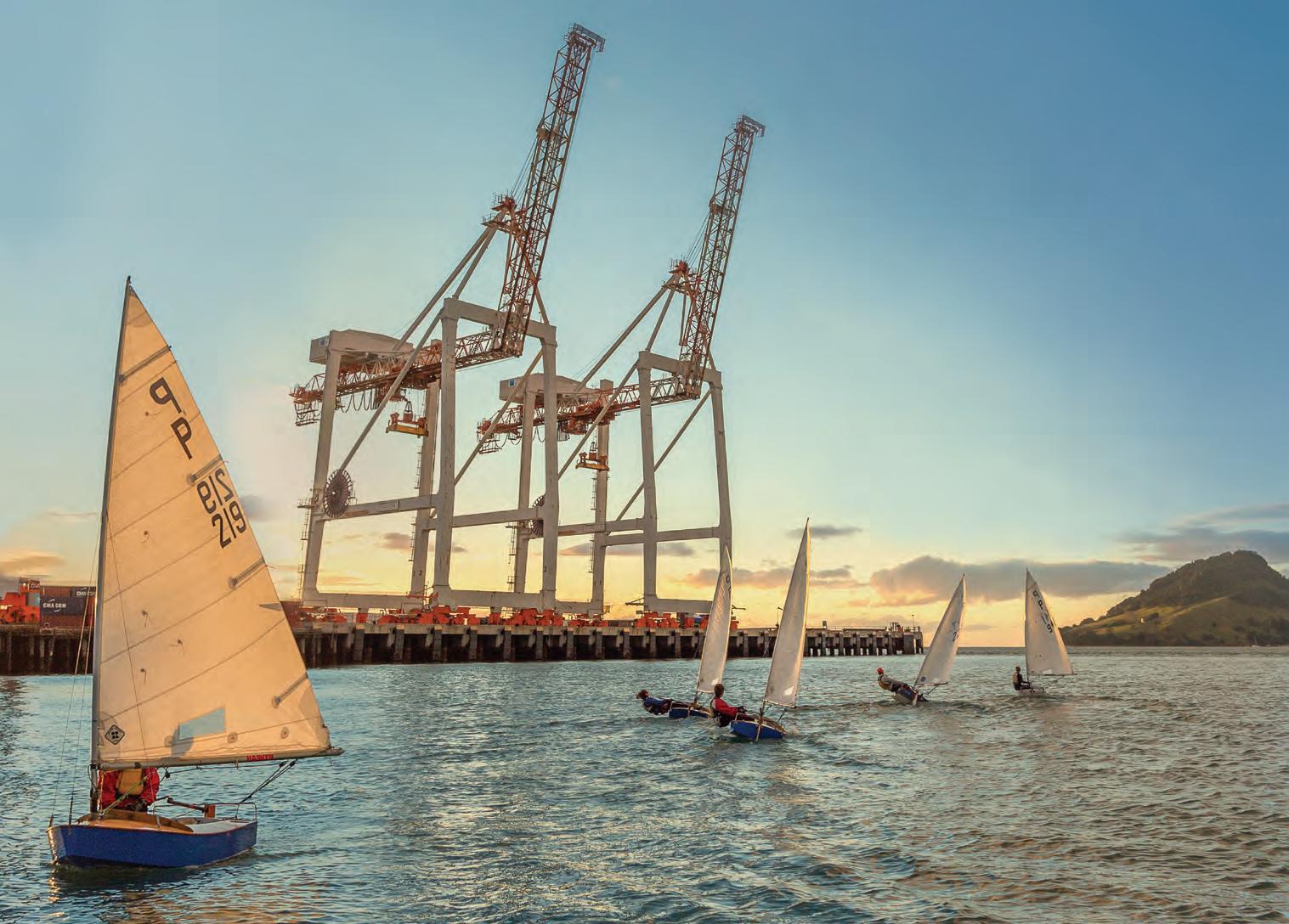
The applied and vocational higher education and training sector in New Zealand is in a state of much-needed change. However, the most significant shake-up for the industry in modern history hasn’t arrived only on the back of a fundamental once-in-alifetime sector reform – it’s equally come via a life-preserving response to a virus.
The Covid-19 pandemic challenged and changed the very nature of what was primarily a face-to-face teaching, learning and support model; and the physical nature of our office workspaces. But with this adversity came opportunity.
Digital technologies (such as Artificial Intelligence, Machine Learning, Virtual Reality, Augmented Reality and Quantum Computing) and novel communication solutions (such as wearable technology, conferencing technology, social media platforms, podcasts, WebChat and group forums) enabled and equipped us with the digital platforms and tools to transform the applied and vocational teaching and learning experience.
It helped us adapt our teaching and learning practices to minimise the health-risk impact on our ākonga (learners) and ensure their learning needs remained firmly at the centre of what we do. It demonstrated the flexible skillsets of our teaching and support staff but also highlighted the direction of professional development needed going forward.
These conditions have created unique challenges and opportunities borne out of necessity, catapulted us decisively into the future technology-enabled world of work, and have resulted in an enhanced ākonga and kaimahi (staff) experience.
Our kaiako (teachers) maximised learning away from the primary face-to-face delivery and seized the ability to develop independent and remote learning skills in our ākonga. The increased dependency on ever-evolving ICT technologies prompted our teams to enhance their digital literacy and adapt to a more fluid approach to their ‘new’ office-home technology-enabled working environments.
The exponential pace of digitisation means that we must better prepare our kaimahi and ākonga to be able and adaptive to engage in a
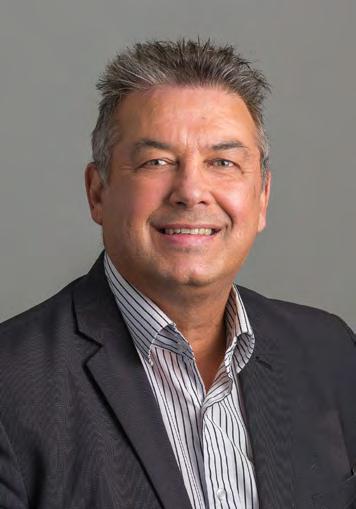
DR LEON DE W FOURIE, Chief Executive at Toi Ohomai Institute of Technology
Kiwis returning to our shores, and the high demand for skilled workers in local industries, we find ourselves able to bridge the training and workforce gap for our communities.
By offering quality, accessible technology-enabled education and upskilling opportunities for our people, we ensure that our rohe has the right people, for the right jobs, at the right time.
For the applied and vocational higher education sector, the change brought about by the pandemic coincided with the establishment of Te Pūkenga – New Zealand Institute of Skills and Technology, which brings together a unified network of polytechnics and industry training organisations across New Zealand. It
The exponential pace of digitisation means that we must better prepare our kaimahi and ākonga to be able and adaptive to engage in a fully digitally-led online learning and working environment. The benefits will also enhance ākonga learning-platform choice or mobility and improve traditional face-toface modes of in-work and oncampus.

fully digitally-led online learning and working environment. The benefits will also enhance ākonga learning-platform choice or mobility and improve traditional face-to-face modes of in-work and on-campus.
We have to consider how we will ensure digital equity and wellbeing for staff and students as we continue to respond to growing demand and need to operate more effectively across all modes of learning.
The pandemic has also highlighted areas where we need to develop more authentic training and education opportunities. With more
will create seamlessness between on-the-job, on-campus, and online vocational education and training delivery through a connected and sustainable network of regionally accessible provision.
The aim is to achieve collective regional impact, which will enable the Bay of Plenty and South Waikato to be more connected to and leverage off other parts of the network, to provide greater flexibility in what, where and how our ākonga learn.
The establishment of Te Pūkenga is helping Aotearoa move to an applied and vocational
education system that puts ākonga squarely at the centre. In particular, giving real effect to our Te Tiriti o Waitangi commitment to further aspirations of Māori ākonga and are fundamental to the way we will work together to achieve equity outcomes.
This shift moves us away from fitting life around learning to provide learning that works around people and their world.
Much of this work is steeped in innovative and digital practices, connecting campuses and curriculum across the country. It will be the cornerstone of a cohesive, sustainable applied and vocational education system that will improve wellbeing outcomes for all New Zealanders and supports a growing, bustling economy.
While applied and vocational education and training is changing in New Zealand, it’s a journey that will take time. However, through ongoing engagement with our stakeholders and partners, we will ensure the new-look systems and operating model delivers fit-for-purpose education and training that helps businesses and communities thrive.
Importantly, we’re also engaging with our
current and future ākonga to help guide us in what Te Pūkenga will look like for them. Toi Ohomai is highly supportive of these muchneeded changes and remains committed to ensuring the workforce and education needs of our rohe are met.
Whilst the advent of the Covid-19 pandemic and the Reform of Vocational Education were initially unrelated, their simultaneous arrival have emphasised the need for a new way of delivering applied and vocational education. These changes we are undergoing are of particular importance for those communities and businesses who continue to battle through the uncertainty of the pandemic and the digital demands of the future of work.
Using the latest technologies, techniques and teaching practices, we can apply what we have learned during this pandemic to build workforces that enable future-focused industries and businesses.
Although we know things won’t go back to the way they were before the pandemic, we need to continue to look to the future and seize the opportunities we have to reimagine how we work, learn and teach going forward.

Our expert tutors are well connected with local employers. They’re here to empower your learning and guide you every step of the way.
You can choose from more than 150 courses with full-time, part-time, and online study options that will best suit you. Study your way with Toi Ohomai.


ANDREW WILSON, Chief Executive, Rotorua Economic Development
“Ithink it’s easy to look back over the last several months and feel like we’ve been treading water but when you stop to think about it, we’ve actually ticked off some significant pieces of work which will leave us in a really good position now that we’ve started to prepare for the visitors to return.”
Meet Andrew Wilson, a self-professed ‘glass is half-full sort of guy.’ He joined Rotorua Economic Development (which is both the RTO and EDA for the district) as the chief executive shortly after the Covid19 pandemic reached New Zealand’s shores. The crippling effect of the pandemic is said to have brought the country’s number one tourist destination and Rotorua’s third-largest income earner to its knees.
“When I came into this role 12 months ago, I took the view that the environment was going to be shifting pretty rapidly so there was a degree of ‘we’re going to have to ensure we’ve got an organisation which is agile and able
to respond quickly,’ so that’s the lens we’ve applied.”
With Rotorua’s tourism economy under major threat due to lack of visitors, the RED team rapidly adapted to meet the needs of the local business community.
“We’ve certainly had a strong focus on trying to think and see through the pandemic to the other side. We’re looking at what that means to this destination overall and how we can ensure that we’ve used this time to rethink how the destination operates.”
The recent development of the Rotorua Destination Management Plan speaks volumes in terms of Andrew’s persistence that iwi and the wider community must be engaged in the work that RED does. Equally important is the need to land on common goals and aspirations across the four wellbeings.
“Within the Destination Management Plan is a really ambitious set of actions which we can absolutely say hand on heart are the right ones for Rotorua. They’re tailored to this place and people, which is ultimately what is most important.”
Andrew has also been incessant about working to address the city’s housing issues. He takes a broad approach in terms of navigating this space and earlier this year he sought approval from Rotorua Lakes Council to extend RED’s role to include transformational place-making projects.
“It’s all about rejuvenating our inner-city at the same time addressing the issue around lack of houses. I think we’ve made some better progress in terms of having a sensible discussion about what levers we can actually pull as an organisation so the additional mandate to be able to look at how we facilitate inner city living, for example, which has spinoff benefits to the tourism sector and wider visitor industry.
“Ultimately what we’re after is a vibrant inner city and the best way to have a vibrant inner city is to have people living there. Every big city in the world has that kind of feeling.”
In the midst of responding to the impact of the pandemic, and helping to address issues associated with housing, RED has also been involved in a significant piece of work that is aimed to enhance the place brand of Rotorua.


“We’ve taken the time to have a real good look at the place brand for Rotorua to make sure it actually speaks of and to this place.
“It’s unique, it’s clearly identifiable, it’s really cool. It feels like it’s got a foot in the past in terms of referencing who we were but it also has a nod to the future in that we’re actually a modern and vibrant destination. I really believe it will leave us in a great position as we start to think about our marketing campaigns and how we present the destination overall. That’s going to be a really exciting journey over the next couple of years as we see it come to life.”
Looking forward, Andrew is optimistic and believes Rotorua is really well positioned to capitalise on the return of visitors.
“I’ve been super impressed by businesses that have taken the opportunity to pause and reinvest or rethink their delivery, there’s been a lot of innovation and some exciting new projects in the pipeline. It’s really encouraging to see change in the hospitality sector with new businesses opening recently.
“To me those are signs of regrowth, an indicator that everyone’s starting to look more optimistically to the future.”
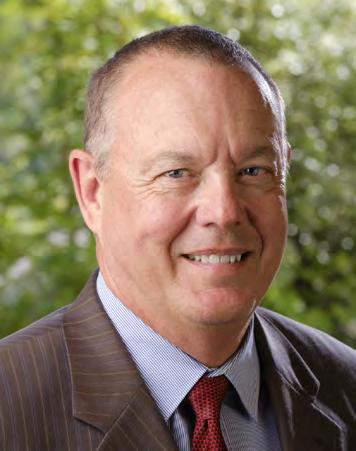
DR JULIAN ELDER, Chief Executive, Scion
Anything made from fossil fuels today can be made from trees tomorrow. Plastics and fuel for cars, planes and power stations can all be made using wood from sustainably grown trees. So when the world gathered at COP26 in Glasgow and agreed to take action on coal power and fossil fuels for the first time ever, innovations developed at Scion became even more important in creating our low-carbon future.
Scion chief executive Dr Julian Elder said forestry is a key part of climate change action and the transition to a low-carbon, biobased economy.
“We are helping make this transformation through our purpose-driven research and our partnerships with industry, Māori and the regions.
“We are based in Rotorua which is the heartland of forestry. This helps build relationships with many who share our vision, which we describe as prosperity from trees, mai i te ngahere oranga.”
Dr Elder said that Scion is working in three impact areas: focusing on growing healthy and resilient forests, creating high-value timber products, and developing biobased products to replace materials derived from fossil-fuel carbon. Scion works to incorporate a Te Ao Māori perspective across every element.
New Zealand needs to plant more indigenous forest and Scion has been working on ways of growing seedlings faster and for less cost.
Elder said Scion’s work has significantly increased the growth and survival of indigenous tree seedlings, which is crucial to grow new forests.
“Our innovations can significantly reduce the cost of establishing indigenous forests which will help New Zealand meet its goals for a carbon-neutral future.”
Forestry tools developed to address climate changes
Scion has deep experience in plantation forestry with radiata pine. Over the last 50 years, Scion’s work at Puruki Experimental Forest near Taupo has underpinned New Zealand’s plantation forestry, resulting in tools that help forest managers predict forest growth, carbon uptake, and nutrient use.
This significantly increases forest productivity and insights into forest nutrient balance for sustainable farm and forest businesses that protect the environment.
“The data and models from Puruki Forest underpin almost every management decision modern forestry companies make today,” said Elder.
“These insights will help forest growers adapt to the challenges of a changing climate.”
Forests are a renewable resource at the heart of a circular bioeconomy
Elder is passionate about ensuring that instead of “take, make, waste”, companies think about how a product will be used across its life cycle.
Scion is among the global leaders in this circular bioeconomy approach, from growing renewable resources, through to new materials, energy and new manufacturing methods.
“The circular bioeconomy could add $30 billion to New Zealand’s GDP. Scion’s Strategy 2030 is centred around driving the innovation needed to realise this opportunity and to help New Zealand and the world meet its climate change targets,” Elder said.
Pitching a National Bioproduct
To help deliver this, Scion sees the need for a National Bioproduct Innovation and Pilot Facility centred in Rotorua to show that lab-based innovations can work at the commercial scale
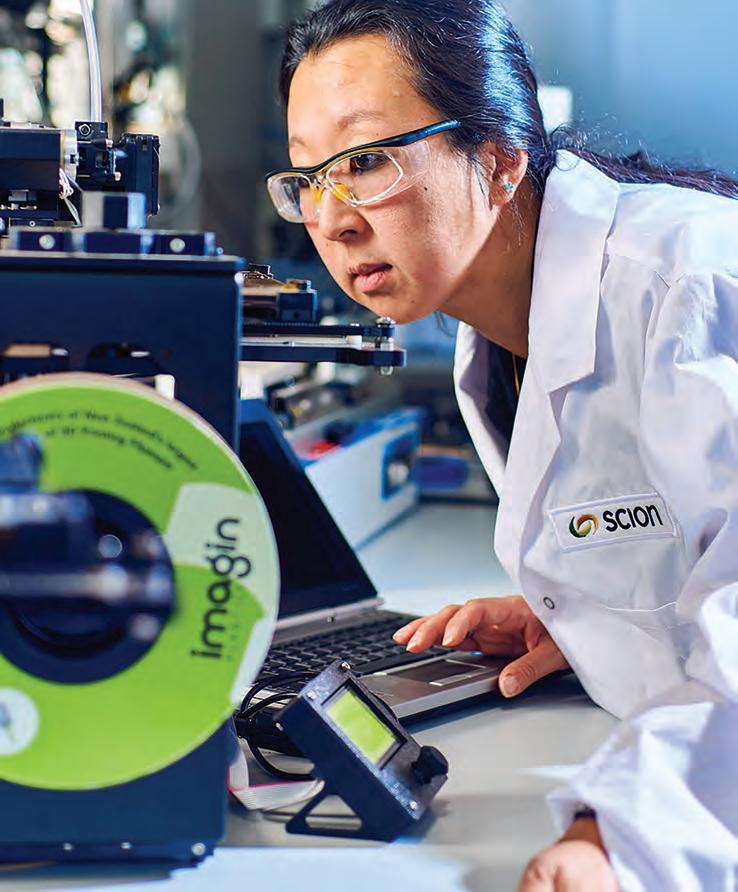
needed to drive the transition to a low-carbon future.
Some of these innovations include techniques to:
• Close the loop on construction waste by extracting preservatives from demolition timber;
• Develop biodegradeable bioplastics made from trees;
• Solid and liquid biofuels – working on sustainable aviation and marine biofuel;
• New low-carbon packaging solutions.
“A domestic biopilot facility would help bridge the gap between science and commercial operation,” explains Elder.
“This is vital to unlocking the innovation needed to meet our country’s goal to be carbon zero by 2050,” he said.
The role of wood in construction
Scion’s innovation hub, Te Whare Nui o
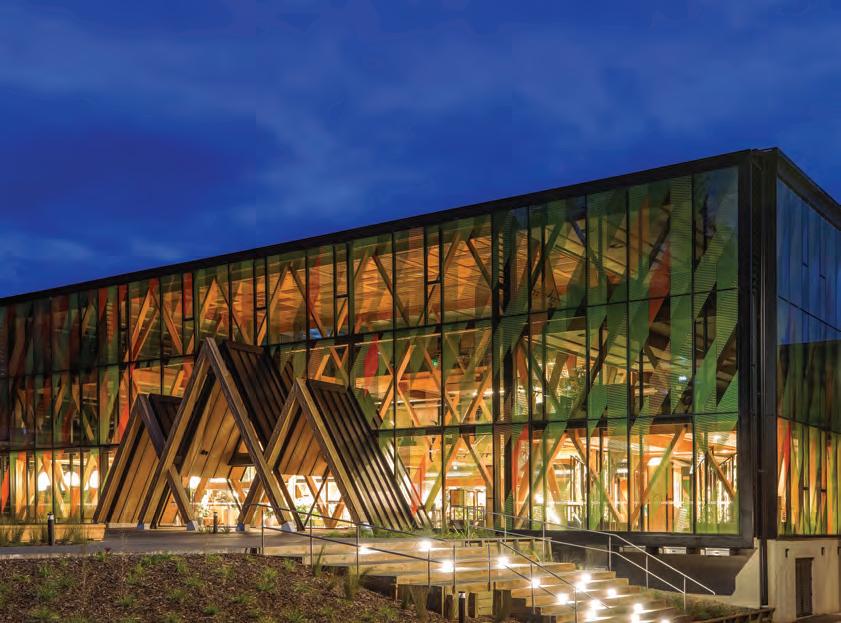
Tuteata opened in March this year and is an award-winning showcase for engineered timber products and building techniques. Its bold and innovative structural form is built to meet expectations for sustainability and environmental performance.
“Wooden buildings like this are an enjoyable working environment, can be designed to result in low damage from earthquakes, are highly fire resistant, and store carbon for the life of the building,” Dr Elder said.
“New Zealand’s radiata pine forests can regrow the amount of timber used in Te Whare Nui o Tuteata, in just 35 minutes. That’s amazing.”
It’s a beautiful building too – it has just won the World Architecture Festival Award for Higher Education and Research buildings.
The ground floor is open to the public and includes an experience centre which visitors are welcome to come and check out, while also enjoying a coffee at Eastwood café.

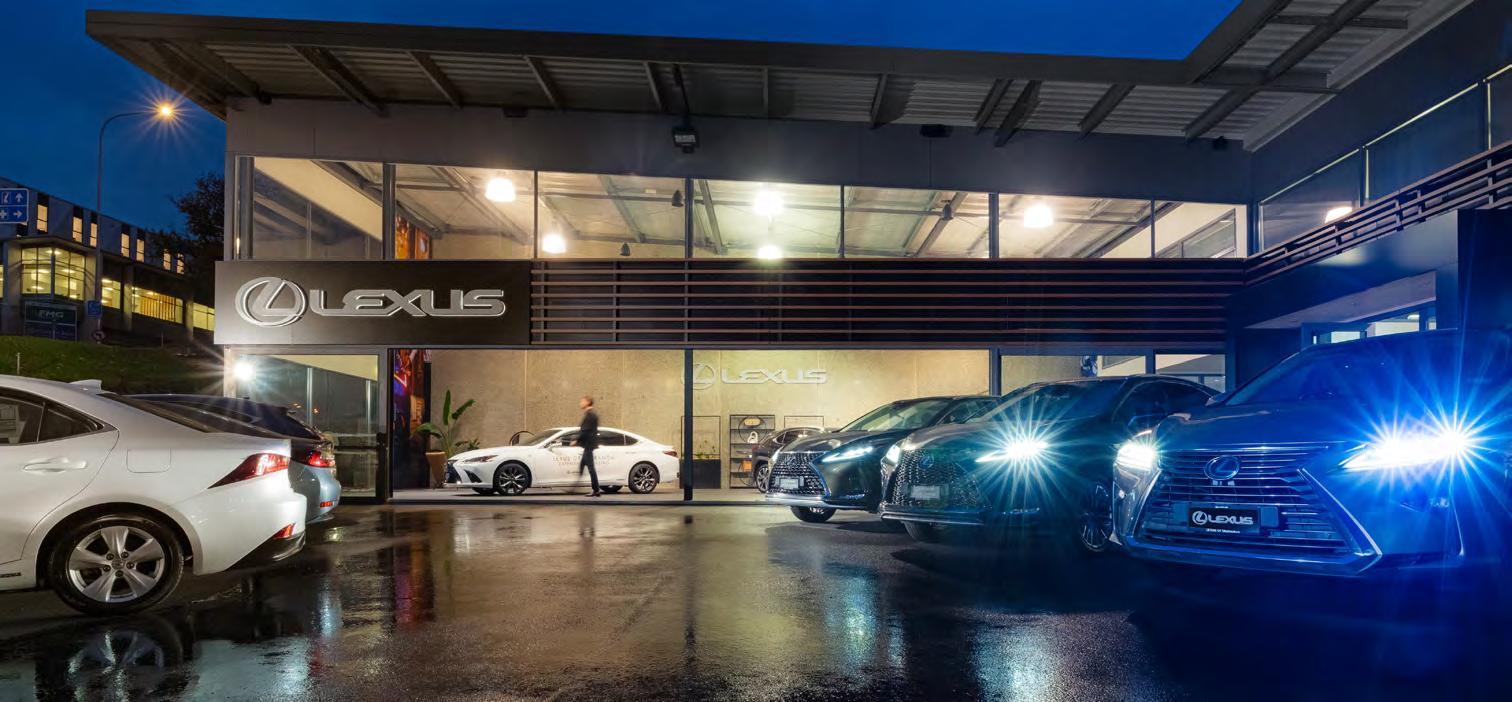
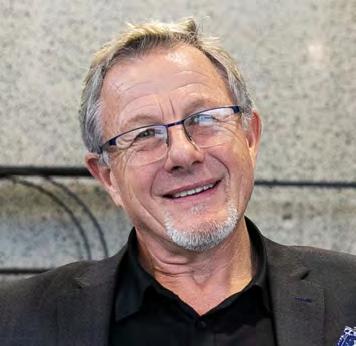
As a relatively new brand in the New Zealand automotive scene, Lexus has been a trailblazer in automotive development since 1989, where luxury, brave design, imaginative technology and detailed craftsmanship have driven the evolution of Lexus.
The quest to create a luxury vehicle superior to even the best European model on the road drove Lexus’ first chief engineer, to push the boundaries beyond what was expected. The constant desire to be better and take a futureled approach has allowed Lexus to craft revolutionary designs that continue to propel the brand into the future.
Proof of this future focused innovation from Lexus was in the launch of the first ever luxury hybrid electric vehicle, the RX400h in 2005, a good four years before any real luxury competitor arrived on the market.
The RX range is still one of Lexus New Zealand’s best selling hybrid electric SUVs and now with 23 hybrid electric models available in the New Zealand range, Kiwi customers are spoilt for choice. This choice is reflected in Lexus sales with 2021 alone seeing 69%


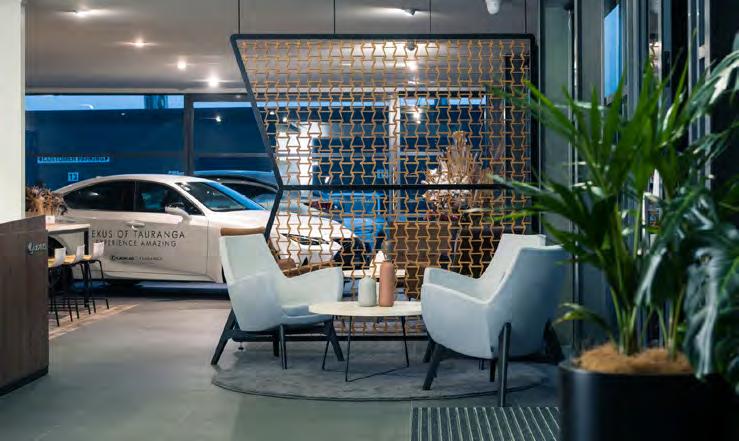
of New Zealand Lexus customers choosing a hybrid-electric model, confirming that luxury customers are embracing both lower emissions and luxurious driving enjoyment.
Lexus already has one of the lowest overall CO₂ emission averages locally due to the high proportion of hybrid-electric vehicles (HEVs) that are sold here. The evolution of Lexus hybrid electric and electrified technology has come a long way in a short 16 years, and the passion for quality, future focused yet human-centric design has remained.
The human-centric approach to everything Lexus is also known as ‘Omotenashi’ in Japanese. Omotenashi is about anticipating the needs of others without expectation of reward.
The immediate future of automotive is electrified vehicles and we’re thrilled to launch our first fully electric SUV to the Bay this summer with the new Lexus UX300e model.”
In other words, the experience we are giving to customers is given whole-heartedly.
It’s this amazing experience, I believe will ensure buyers not only keep coming back to us at Lexus of Tauranga, but back to bricks and mortar retail in general.
As we all shop online 24/7, and the introduction of next day delivery stokes our desire for immediate gratification, it has become more important than ever to ensure we at Lexus deliver an amazing experience for every person who walks through our doors.
When we invite people into our showroom we want them to feel that every aspect of their car purchasing journey is personalised to their needs.
When we open our doors, we are inviting people into a comfortable, welcoming space where they are our guests – we are sharing our hospitality or ‘Omotenashi’ with them.
Our new Lexus of Tauranga showroom is more like a hotel foyer than a traditional dealership, and we think it’s the perfect setting for
talking about guest’s dream vehicles. The initial dialogue is not necessarily about the product but more about your lifestyle, what you like, don’t like and what you want to achieve from a vehicle buying experience. As we build our customers trust, this allows an honest and transparent relationship to develop.
It’s about ensuring that when guests leave here, they’ve had a memorable experience that fits with what they would expect of a premium luxury brand like Lexus. Our guests then become our greatest advocates.
As for the future of mobility, we’re living in a period of technological innovation and development like no other generation has ever seen before. The immediate future of automotive is electrified vehicles and we’re thrilled to launch our first fully electric SUV to the Bay this summer with the new Lexus UX300e model.
Our cities are being re-developed and updated to pave the way for an electrified lifestyle and we’re lucky to see this development come to Tauranga, charging stations are appearing in new developments like The Crossing and Elizabeth street re-development as well as the new Hotel, retail and office development in Hamilton Street to be completed by 2023.
I have no doubt there will be a race from all car manufacturers to bring out more diverse electrified model ranges with faster charging times and more kilometres per charge as we all adapt to electric vehicles and demand more from them.
The concept of car ownership continues to evolve too and we’re seeing long term committed car owners looking for more agile mobility solutions for getting from A to B. Ebbett Group (part owners of Lexus of Tauranga) have recently launched a subscription service to cater for people who might need a car for extended periods of time but don’t need to buy. I believe we’ll see more car sharing companies around New Zealand as some of our smaller cities like Tauranga continue to grow. By 2025, Lexus globally plans to introduce more than 10 electrified battery electric (BEV), plug-in-hybrid (PHEV) or hybrid-electric vehicles (HEV) models making it an exciting time for Kiwis and their journey to experience an amazing electrified future.
My team and I at Lexus of Tauranga pride ourselves on ensuring every customer interaction is one that ensures our guests leave feeling as though this is just the beginning of a new journey, of both excitement and stimulation that will culminate in being welcomed to the Lexus of Tauranga family.
Leading Tauranga law firm Cooney Lees Morgan has broken with tradition by appointing a CEO – the first law firm in the region to do so.
Cecilia Burgess specialises in business development and leading high-performing teams and has an impressive track record, having been Chief Operating Officer at both PwC (PricewaterhouseCoopers) and Bell Gully over the past decade.
Her appointment is unusual because Partners still run most New Zealand law firms. The rare few that do have a CEO often have legal backgrounds or are a Partner themselves. But Cooneys has opted for Cecilia’s unique experience within the professional services sector to help the firm grow and evolve in the coming years.
“We are now such a diverse business in terms of our clients and the types of advice we’re providing that we need to ensure our Partners are spending their time working with their clients to solve their legal issues rather than spending too much time running our own business,” explains Partner Peter Crombie.
“We are thrilled to have Cecilia on board and know she will focus on our internal culture, enhance our client relationships, and position our firm for a sustainable future, which is exciting.”
Cecilia will be involved in all aspects of running the firm, including setting the strategic direction and leading initiatives to fulfil that strategy. She says Cooneys’ reputation as one of the best mid-size law firms in the country initially attracted her interest but that was quickly overtaken by the calibre of people she met during the selection process.
“You can immediately tell that this is a group of people who really enjoy being in business together,” she says. “Their level of engagement with, and enthusiasm for, the firm was obvious. They have a very clear sense of who they are and where they want to take the business – which is to be the best law firm of its size in New Zealand.
“I’ve been fortunate enough to have worked in a number of leading law and other professional services firms around the world, and I
would rate partner engagement as the ‘secret sauce’ in firms which do have a positive and sustainable culture.”
Cecilia says the advantage of appointing a CEO with a non-legal background is the ability to stand back and look at the firm’s performance objectively, and to bring an understanding of business management best practice to the table.
“Professional services firms are built on consensus management because that’s part of the partnership model. But what I can do is bring Cooneys’ Partners to that consensus and help explore options along the way with best practice in mind.”
Recruiting and retaining great staff in a market that’s “got a real war for good talent” will be a major focus of her new role.
“Cooneys is able to provide high-quality, challenging legal work on a national scale while also offering staff one of the best lifestyles in New Zealand. It’s an enviable position and one of the key reasons why the firm is so highly regarded within the legal fraternity.
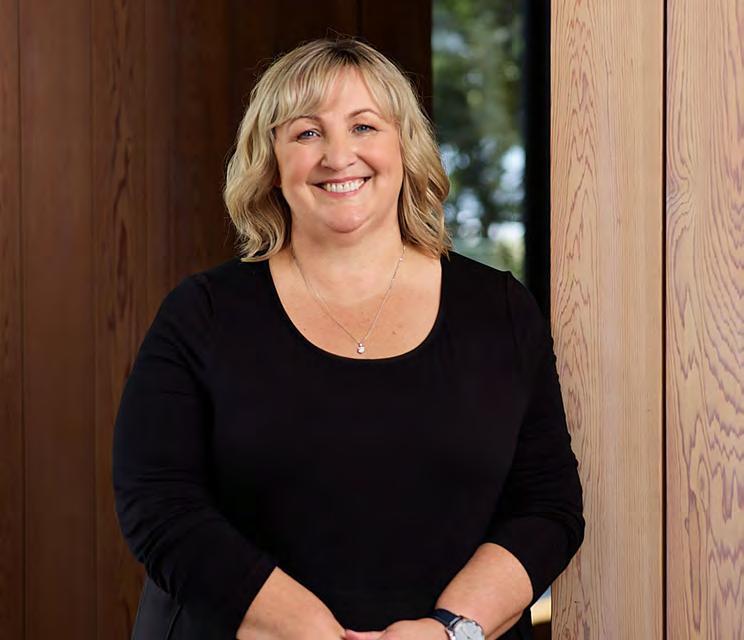
CECILIA BURGESS, CEO, Cooney Lees Morgan
Tradition is really important and Cooneys has got fantastic clients that they’ve had for years. But they believe they can always do better. We operate in a different world than what we’ve had in the past. We’re facing different challenges, and as one of the leading businesses in Tauranga we have our part to play in the community in which we operate.”
Many of our lawyers have worked at top tier firms in Auckland, Wellington or overseas –but have chosen to make Tauranga their home to enjoy the best of both worlds.”
Setting the business up for a sustainable future is another key goal Cecilia is working towards. She says there’s a genuine sense of
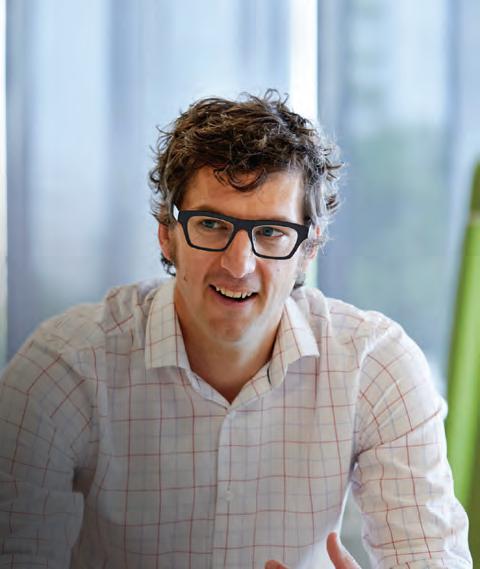
kaitiakitanga among the current Partners to ensure the firm’s 100 year+ legacy continues.
“Tradition is really important and Cooneys has got fantastic clients that they’ve had for years. But they believe they can always do better.
“We operate in a different world than what
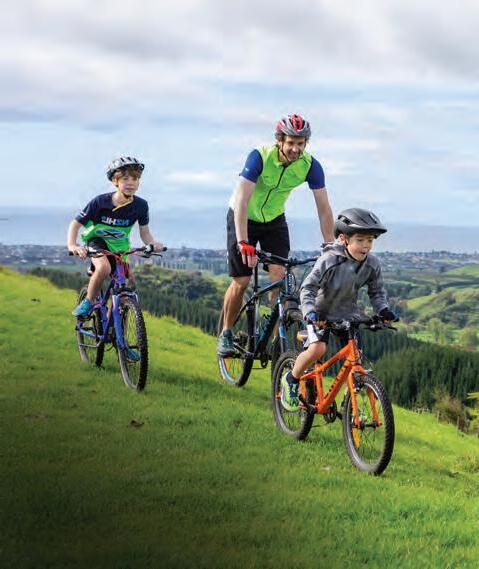
we’ve had in the past. We’re facing different challenges, and as one of the leading businesses in Tauranga we have our part to play in the community in which we operate, and I think there’s a real recognition of that.”
Prior to creating the new CEO role, Cooneys appointed independent Chair, Carlos da Silva to its Board in 2020. The experienced businessman and director has helped steer the Trelise Cooper Group, FlexiGroup NZ, IT Partners, Fisher & Paykel Finance, NZ’s Meteorological Service, Waikato Regional Airport and the Greenlea Group, among others.
“My appointment, coming on the back of Carlos’ appointment as Chair, demonstrates the focus that Cooneys’ Partners have on building this firm and looking to the future without losing the strength that comes from having been in business for over a century. I’m ready for the challenge and look forward to helping the firm thrive for many decades to come.”

HOLLY BROWN, Chief Purpose & Transformation Officer at Comvita Limited
“People first, every time.” That’s what her LinkedIn profile says and that focus is quickly borne out in conversation with Comvita’s Holly Brown. Her job title at the country’s largest and leading Mānuka honey company, could leave one wondering exactly what she does, until you realise she began her career in human resources.
Holly spent nearly eight years with Zespri as Head of HR before taking up the position of GM Greater China in 2015.
Working out of Shanghai, she led the business through a time of extraordinary commercial challenge and disruption.
Now with Comvita, she has spent two and a half years on an executive team which has overseen a strong business turnaround, built on a focus on quality and brand.
The hardest thing about being a New Zealand brand she says, is maintaining that quality and consumer focus.
“Really, New Zealand businesses in a sector should be working together to differentiate as a (high-end) category in the marketplace. The strength of an international subsidiary model is that it’s not a race to the bottom on price. Focusing on quality and standards is a winning strategy, but a huge challenge in a competitive market like Comvita’s.”
In her experience, developing product standards is a good way to ensure that quality is maintained in any sector.
Whether that’s working with the Ministry of Primary Industries, identifying industry-led measures or looking to technology to drive greater innovation, Holly says standards validate quality.
Shanghai was a sensorial experience for Holly, a city of contrasts between the two sides of the river, the ancient and modern bunds, serenity and high society. She describes moving between a temple to the glitz and glamour of the high streets and says the pace of the city was amazing and addictive. Amid all of that came some great lessons on doing business in China.
“The ability of my counterparts to think long term and learn from the past was such a lesson in sophisticated thinking and planning,” she says. “I learned about the circular nature of business, understanding reciprocity and how that flows in a powerful and positive way. And I relished the subtlety of the culture, all of those tiny cues, which my colleagues were good enough to ignore when I missed them,” she says with a smile.
Learning from Ma¯ori
Holly is quick to acknowledge that while she learned the lesson of long-term planning in China, she could just as well have picked it up from the iwi she now works with at Comvita.
“It’s sad as a nation that we’re not doing enough to learn from the past and from each other.
“At Comvita, we would still describe ourselves as at the beginning of our journey in learning how to be better partners with Mana Whenua, but we share a huge love and respect
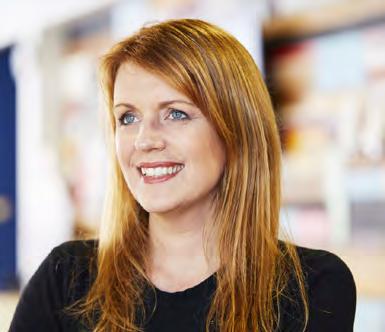
for the land and that goodwill goes a long way.”
Comvita and other large Mānuka honey producers are part of a group working with iwi to trademark the Mānuka honey brand as indigenous and purely New Zealand. The group, the Mānuka Honey Appellation Society, is promising to hand control over to a Māori Charitable Trust should it win the application.
Many New Zealand exporters see China as a growth market, so how has Comvita managed to achieve sales growth of 31% on the mainland in 2021? The key is in people again. In the last 18 months, Comvita has got closer to its customer and consumer in key global markets.
“It’s been about investing in and empowering the talent on the ground, especially with the creation of a Regional CEO for China. That’s made a massive difference in enabling us to position Comvita locally as a premium lifestyle brand. Before we had a global distribution strategy, now the focus is on positioning and brand.”
Being purpose driven
Having a “human and values centred approach” to business is also one of Holly’s mantras. By that she means purpose. She says it’s refreshing that purpose at Comvita has been a major factor in its increase in earnings to $25.5m. Comvita has recently released what it calls
When the culture and leadership of the organisation reinforce an authentic and meaningful purpose, the results follow. That’s manifested in the Harmony Plan, so that as we grow, we invest in our people.”
the Harmony Plan, its own environmental, social and governance (ESG) guide to doing business in the future, which it encourages others to adopt.
The plan addresses climate change, seeks to restore nature and support communities and provides a guide to the company’s partnerships and social impact initiatives.
“The Harmony Plan is a statement of intent. It demonstrates to all our stakeholders how we want to show up and make an impact as an organisation,“ says Holly. “It’s a way of holding ourselves and others accountable. We will be publishing an annual record of our progress for all to see. That transparency is good for us.”
Comvita has pledged to gift 1% of EBITDA to global community partnerships in support of better social and environmental outcomes; to plant a tree for every pot of mānuka honey sold; and to save 1M bees globally every year. It has already planted more than 10 million trees since 2016.
Those people again
Another goal is to have all 550 or so staff as shareholders. “When the culture and leadership of the organisation reinforce an authentic and meaningful purpose, the results follow. That’s manifested in the Harmony Plan, so that as we grow, we invest in our people.”
“It may take us time, but we’ve put it out there in lights,” says Holly. “Purpose, trust, belief in people, they’re key.”

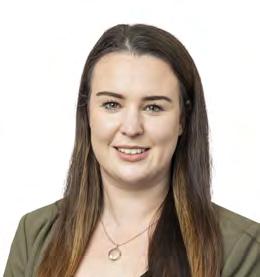
By ALAN NEBEN
In late November Bay of Plenty Business
News’ Alan Neben spoke at length to Strategic Pay’s Tauranga consultant Dayna Mears. Her thoughts on significant changes to the employment and remuneration landscape over the last 12 months suggest a sea change, not just a small shift, is occurring; Her message to businesses employing staff now and into 2022: “If you’re not going to offer flexibility, don’t expect to fill the position.”
Dayna has been a Bay of Plenty resident for many years and has a wealth of experience in the human resources and remuneration fields, from both sides of the fence – as a client of Strategic Pay seeking their expert advice, and now as a specialist representing Strategic Pay.
“Why Strategic Pay?” I asked her.
“Well, we are the biggest provider of remuneration advice in the country – that makes a world of difference when you need to know how the market is moving.”
“We have New Zealand’s largest database across not-for-profits, the private sector and the public sector. We have more than 220,000 data sets available to our clients – we pride ourselves on our stewardship of that hugely valuable data resource,” she says with satisfaction.
“And the team at Strategic Pay were always wonderfully efficient and friendly to deal with, so the decision to join their business was not a difficult one for me.”
In looking for source material from Thought Leaders for this issue, Dayna Mear’s comments provide an excellent overview of remuneration trends across all industries – broad-ranging, up-to-date and accurate.
She points out that in her opinion there was a distinct difference in thinking and impacts for her clients between 2020 and 2021 – in 2020 many businesses drew back their services and put projects on hold, largely as a result of uncertainty.
“Come 2021 however, we saw consumers hold their confidence. With this confidence has come unprecedented growth – growth that has seen us busier than ever before.”
In our discussion, Dayna used a term describing a trend that has emerged in Covid times – The Great Resignation – a phenomenon that is affecting supply, attraction and retention of skilled labour now, and she predicts will continue to do so into the future.
The Great Resignation has had a devastating effect on the availability of skilled labour. It has been bought on by the effects of Covid19 lockdowns, work-from-home changes and a general realigning of lifestyles by many of those impacted; with Covid-19 as the catalyst, many people have chosen to ‘throw in the towel’, leave their jobs and re-focus their lives.
The impact on supply of experienced skilled talent leaving across industries has been extensive. Combine this with border closures and immigration restrictions and we see a demand curve emerging which is not easily able to be met by supply. This effect is particularly acute in construction, engineering and IT.
I asked Dayna what this means for businesses needing to employ and retain skilled staff.
“Expectations have to change and now flexibility is not just expected, it is essential, in remuneration offers for employees, new and existing.”
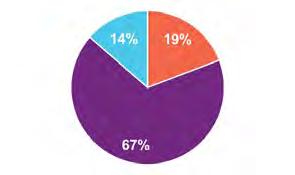

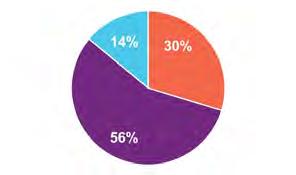
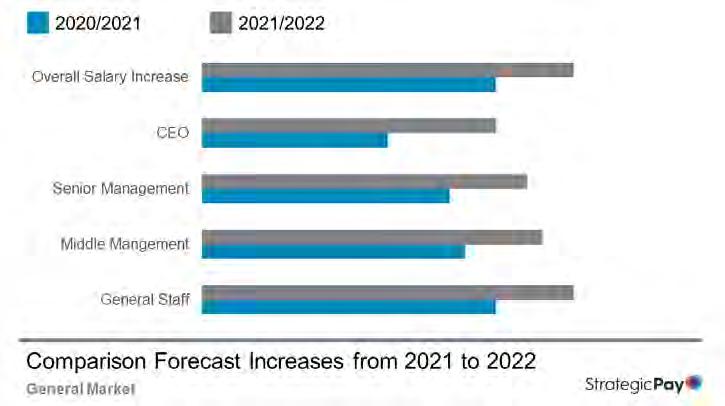
What exactly does she mean by flexible remuneration? Specifically, bonuses, extra leave days, flexible worktimes, work-fromhome options, and the like.
In Dayna’s words, “If you’re not going to offer flexibility, don’t expect to fill the position.”
The culture change marked by the new ‘flexible’ offers represents an exciting new development.
It’s refreshing to see remuneration packages meaning more than just numbers.
A legacy of the lockdown work-from-home era is a change in expectations – strict 40hour work weeks and 9-to-5 workdays are a thing of the past across many positions and industries; And gone are the days when remuneration packages were about the monetary salary only – it’s the flexible elements that ultimately appeal to workers.




Embodying everything that has made the Audi Q5 a bestseller, this Audi Q5 Special Edition also boasts $14,000 of extra features from aesthetic to function, to pure fun. With all of this for just $95,900 (MSP), the Audi Q5 Special Edition is a vehicle not many will see, but plenty will hear about.
Special Edition Features: 20” Alloys in Segment DesignAdaptive Cruise Control - 3-Zone Airconditioning- Audi Virtual Cockpit Plus - High Beam Assist - Comfort Key – Keyless Access - Power folding, auto-dimming with memory exterior mirrors -Font Sport Seats - Power seat with Memory Drivers Seat - 4-way lumbar support

As the weather gets warmer around Tauranga so does the line-up of summer events at Trustpower Baypark.
Baypark Speedway
The Speedway season is ready to kick-off once the government gives the green light to start the first race. Baypark Speedway begins with Opening Night on Saturday 4 December 2021. This will be followed by a line-up of speedway meets throughout the season for all of the adrenaline junkies. All speedway dates can be found at www.bayparkspeedway.co.nz.
To enjoy watching the races in style, we have a number of Corporate Boxes available to entertain your guests comfortably. Our corporate boxes offer an exclusive, spacious and comfortable environment all with outdoor balcony for up to 20 guests accompanied with bar service and catering delivered by dedicated hosts.
Polo in the Bay
Polo in the Bay is more than just a new event, it’s a whole new tradition on Saturday 22 January.
The inaugural event features some of New Zealand’s most talented Polo players going head-to-head in their provincial colours and this fresh Polo format brings you closer to the action
– there isn’t a bad seat in the house.
There will be a range of hospitality options available, from a casual picnic-style Family Zone, to Private Marquees and the VIP Pavilion with specialty bars, catering and lounge areas.
Polo in the Bay features include:
• Movember Brunch (R18)
• The Polo Lawn (R18)
• VIP Pavilion (R18)
• Private Marquees (R18 – limited spaces)
• Free Family Zone (unlicensed –all ages)
• Après Polo – Eat + Drink + Play at our Official Dining Precinct Tickets available from www. polointhebay.co.nz
Nitro Circus
Nitro Circus is returning to Tauranga’s Trustpower Stadium, for the first time in five years, on Monday 7 February 2022.
This news comes with Nitro Circus is in the middle of a six month, 27-city North American tour which stretches from coast to coast, hitting major markets such as Seattle, Phoenix and Nashville. The brand has emerged from the lockdown challenges of 2020 in a position of strength: its total number of shows worldwide this year marks an increase of more than 33% from 2019.
In the decade since launching its touring business, which debuted in Australia and New Zealand, Nitro Circus has gone on to perform on five continents and established itself as a major global live event property. To date, Nitro Circus has performed more than 360 shows in over 30 countries worldwide in stadiums, arenas and festivals with an exciting blend of action sports excitement, jaw-dropping stunts and outrageous fun. Tickets on sale now through www.nitrocircus.com.
Nitro Circus – Hospitality Packages
We have a limited number of corporate boxes available offering hospitality packages during Nitro Circus for the ultimate viewing experience.


Hospitality Package includes:
• Exclusive, spacious and comfortable box for up to 20 guests
• Tickets for Nitro Circus for up to 20 guests
• Attractive catering packages served to your corporate box
Please contact us on events@ bayvenues.co.nz or 07 577 8593 to book your package. These will not last long - contact us today to avoid disappointment.
NZ Bridge – NZ National Bridge Congress

Battle of the Trades IV

tralasia, Armageddon will be here on Saturday 26 February – Sunday 27 February 2022.
New Zealand’s Premier Bridge Event. After the disappointment of not being able to hold a National Congress for the past two years, there will not just be a new venue but there are many other changes as well.
The 35th New Zealand National Bridge Congress is the premier bridge event in the annual calendar and was last attended by over 700 players in 2019. In 2021, it will be held from Thursday 10 February - Thursday 17 February 2022 with events open to all levels of players, from grand-master to Novice players.
BAY BOXFIT is proud to bring to you Base Up BATTLE-OF-THETRADES IV – The Bays Best Charity Boxing Event.
A very popular Corporate Boxing show which showcases tradespeople challenging themselves by navigating their way through 3x 2 min rounds against one another This is a BLACK TIE event so be sure to dress to impress on Saturday 19 February 2022.
Armageddon
Not long to go till Armageddon is here once again! Infamous and one of the largest fantasy events in Aus-
Armageddon Expo is New Zealand’s ultimate entertainment event, featuring gaming, fantasy and multimedia events. Armageddon will be a great day out for all the family – if you have not experienced an Armageddon yet – this is your chance!
Tauranga’s Premier Venue
Trustpower Baypark is Tauranga’s Premier Venue for conferences, meetings, entertainment and exhibitions. Offering a complete package in one convenient location that features state of the art meeting rooms, in-house catering, audio visual services, professional conference organiser (PCO) and marketing/promotional services.
The Rotorua Business Chamber, in association with Te Arawa Covid Hub, is launching a campaign to encourage safer business operations within Rotorua City while the remainder of the outbreak runs its course. The chamber notes: “The reality is Covid19 will run its course on the Un-Vaxxed, while the rest of the community gets on with it.”
The chamber is aiming for positive, proactive encouragement and assistance for businesses who are vaccinated. Also, to encourage all businesses to reach 100 percent vaccinated status as quickly as possible and practical. The campaign is about taking control of the community’s own future and creating certainty and confidence while the pandemic runs the remainder of its course.
The initiative includes: Mobilization of the Rotorua Business community to become proactive with vaccination, and help take control of our own destiny.
• We are setting up and promoting a “100 percent Vaxxed Club” of registered, vaccinated businesses, so customers know where they can most safely trade.
• It is open to all businesses in Rotorua, including non-Chamber members.
• The campaign is intended to be bright, positive, celebrating and promoting businesses who have achieved 100% double vaccinated status.
The Chamber will provide registered 100 percent Club members (free of charge) promotion material, which (so far) includes:
• Branded “100 percent Vaxxed” shop windows stickers
• Branded “100 percent Vaxxed” shop posters (A4)
• Branded “100 percent Vaxxed” banners for business-place signage
• Branded “100 percent Vaxxed” car window stickers
• Branded “100 percent Vaxxed” digital logo to add to email signatures
Far from being only the domain of start-ups and sole traders, flexible office space is allowing large corporates and professionals to be agile in their businesses too.
As the working world becomes more accustomed to responding quickly to external health, social and economic drivers, shared and flexible office space has emerged as a growing real estate asset class –and one that has huge benefits for occupiers.
With all that has transpired in the global office sector since the pandemic’s unwelcome arrival, one thing has become very clear: how and where teams work is not a binary choice between traditional office space and the home environment.
Steve Rendall, Bayleys national director of office leasing, says the need for safety, access to technology, economic flexibility (including the capacity to scale space to meet demand) and effective personal communication are all playing a part in determining what sort of office space is required by businesses.
“Work-from-home, hub and spoke/core and flex, co-working, shared space, serviced office space – these are all evolving workplace solutions and models that business owners are using to ensure their workplace environment is optimised.
“In New Zealand, large corporates and the public sector are quickly adopting global trends in relation to innovative space solutions, that better suit rapidly
changing market environments, budgetary constraints, working styles and staff preferences.”
Bayleys’ latest Coworking Research Report, shows Auckland now has more than 55,000sqm of flexible working space – and a further 19,000sqm-plus in the pipeline.
A recent Bayleys Research survey showed 27 percent of those companies surveyed had more than half their workforce working remotely on a regular basis, which has required the traditional office environment to change in response.
Leading office owners and developers have recognised that while quality “siloed” office space is still a hugely important component of corporate workplace strategy, the inclusion of shared and/or more informal working spaces that add to the overall amenity of office tower and mixed-use precincts is also crucial.
“Institutional landlords and leading private developers are thinking hard about what will draw office tenants and their employees into their building, with flexible access to other more interesting and collaborative spaces within their buildings one way to do so,” explains Rendall.
“They also know that many major corporate occupants don’t have a complete view of what their occupancy requirements look like.
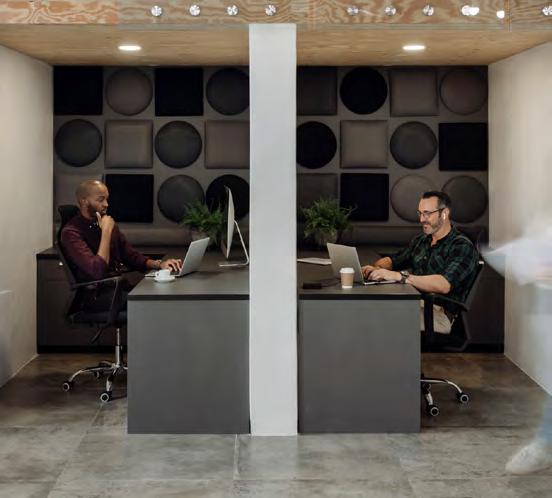
“For example, contractors and consultants are constantly engaged in bidding for infrastructure work, and if the work is awarded to the bidder, there is often an immediate need to upscale affected teams.
“Management can’t easily plan for the increased activity, so having flexible and innovative office space providers within a building can provide an immediate competitive advantage for landlords who are sensitive to these uncertainties.”
Various major participants in the New Zealand market, like Generator, IWG and B:HIVE, along with bespoke operators like Qb Studios, have identified the changing needs of businesses forced to constantly evolve, restructure, and relocate and are meeting these needs by providing adaptable and high quality space.
The benefits of being able to tap into shared space within an established building include:
• Well-designed turn-key (nil
CAPEX) solutions that leverage off global experiences
• Increased agility, in that businesses may expand or contract workspace footprints from one month to the next if necessary
• Flexible lease structures, including membership models, multichoice optionality, and shortterm commitments
• The ability to test new geographical markets, whether across town, or in other parts of the country
• Retaining branding and corporate “look and feel” – or simply running with the best design solutions that have been learnt and enhanced off-shore
• Transparent cost structures
• A commitment by flexi-space operators to provide a safe and hygienic environment - compliance is usually taken care of by the provider.
www.bayleys.co.nz/workplace/ office/insights/share-and-flex



